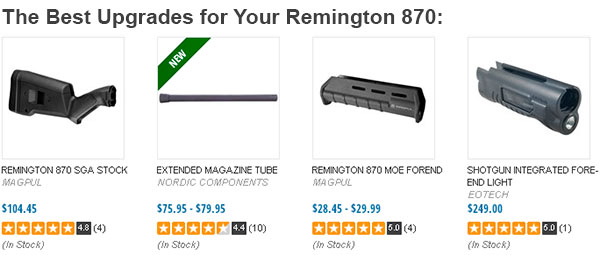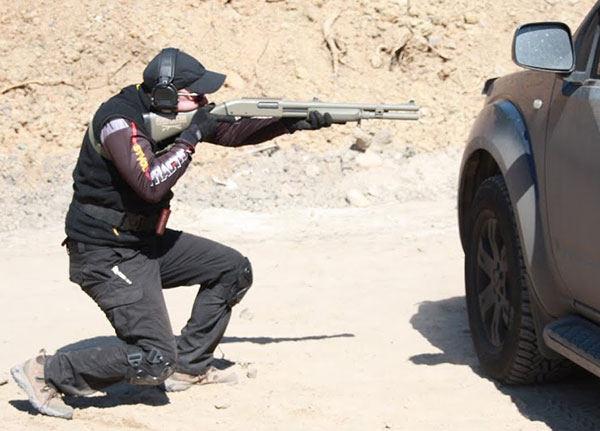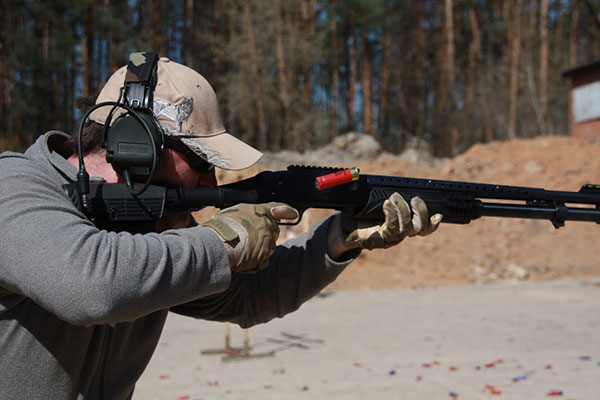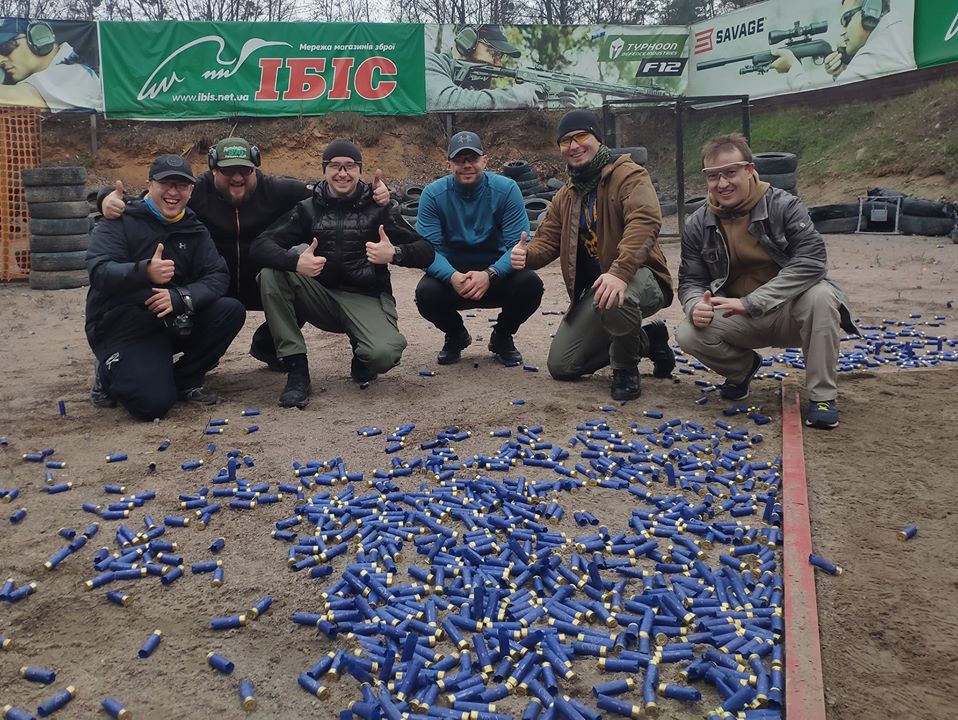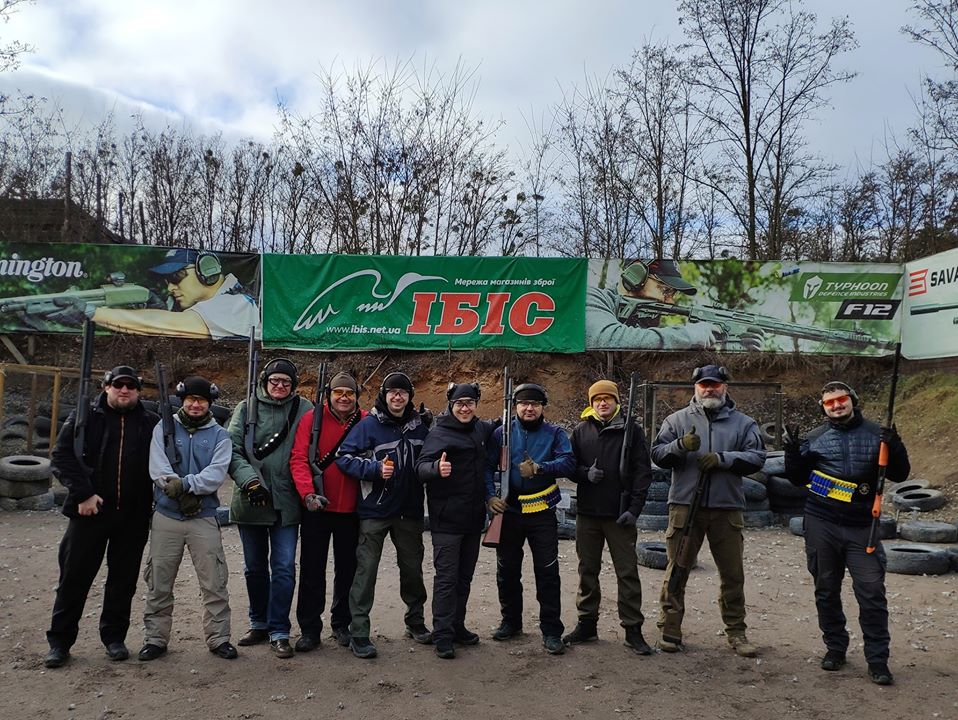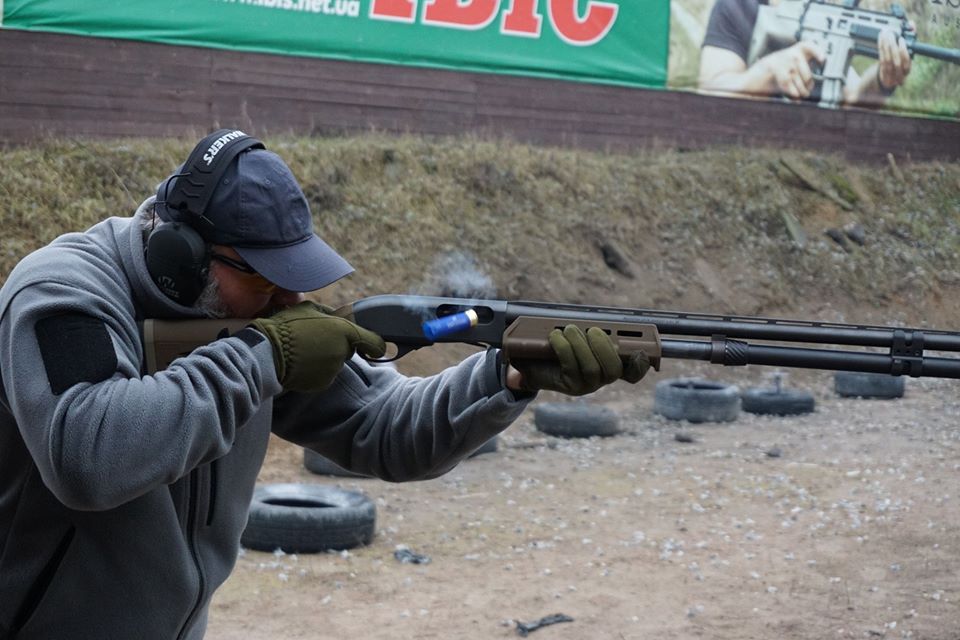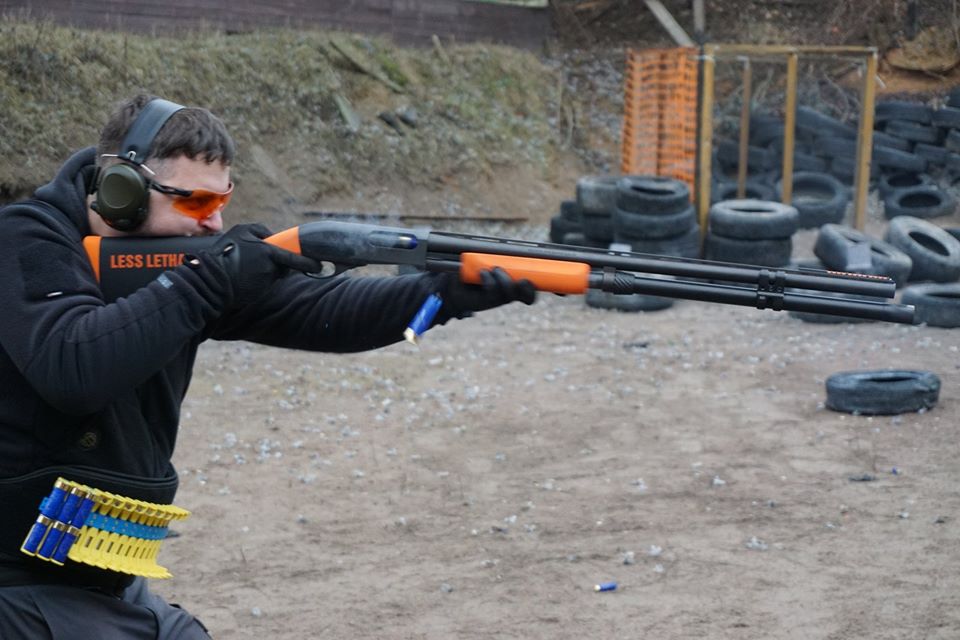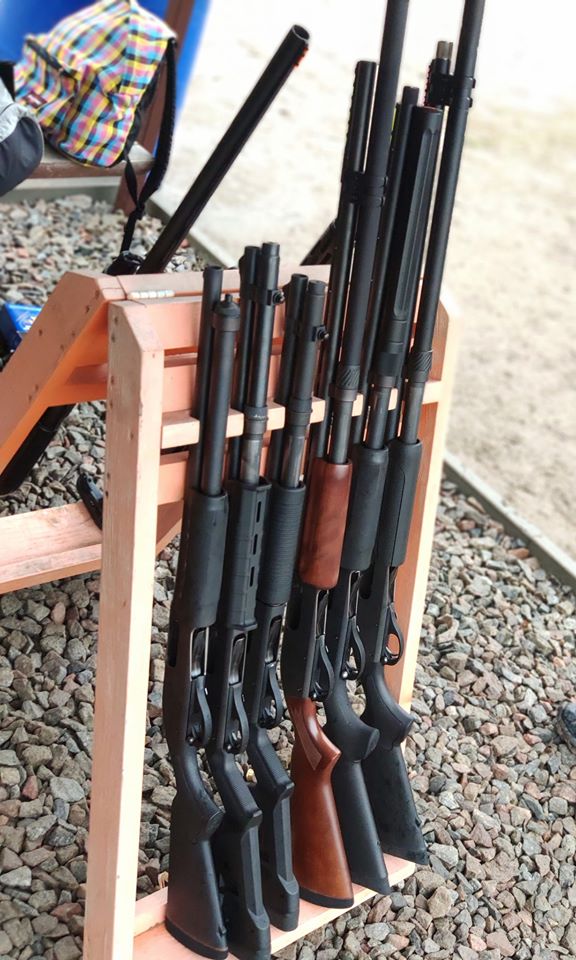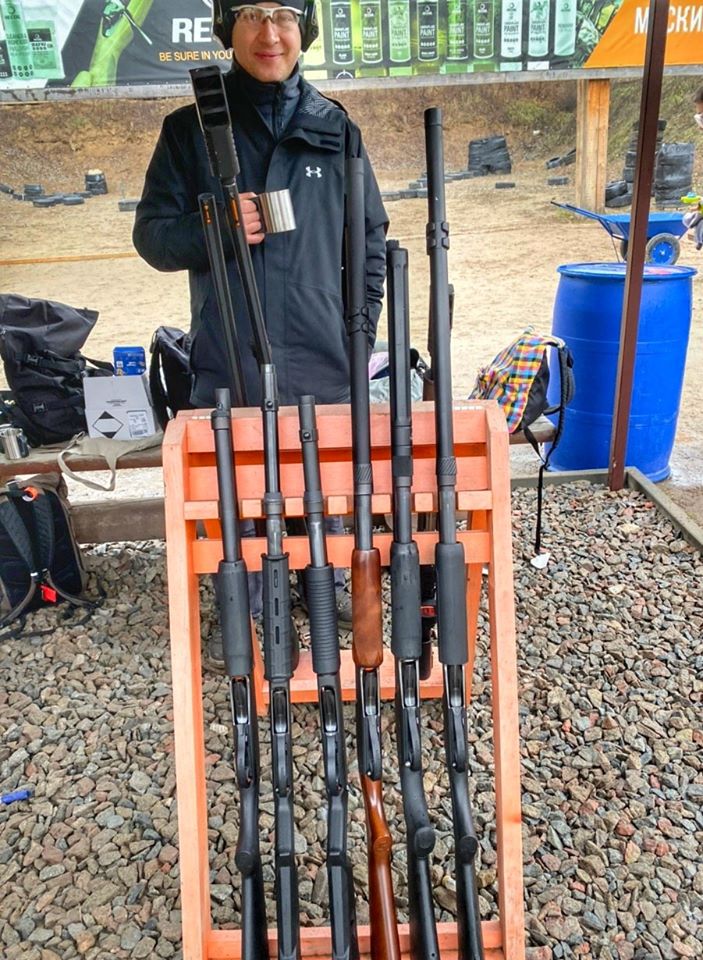My Shooting Courses, Trainings, Tips and Advices
Gathered information about my courses and articles with shooting tips in one place.
Shotgun Shooting Stance
Your shooting stances are important and as always, remember in a firefight the target shoots back. You stance is what sets you up for your next move, because in a tactical situation you fire and move. Left foot in front of the right if you are a right-handed shooter, and feet shoulder width apart. Your weight needs to be shifted slightly forward so your feet are braced and your body balanced for the recoil. Flex your knees slightly to help keep balance after the recoil, and make sure the weapon is tight against the shoulder so it moves the body and does not slam into the shoulder. Having slack between the stock and shoulder means after a day of firing you will not be able to lift your arm the next morning.
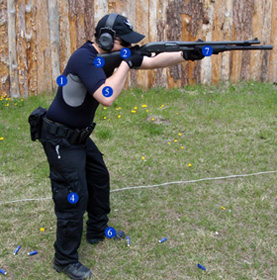
Cheek to stock weld, this is the position your cheek naturally finds when you bring the weapon to your shoulder. Your cheek is against the stock and eyes on target. Practice will ensure you automatically assume this position when bringing your shotgun to bear.
Your hand on the forearm must be such you do not strain it so it begins shaking. Make sure the elbow and your forearm acts as a support by having a bend in the elbow instead of being held straight out. Elbows in close to the body, you want to make a smaller target and when swinging through doorways and around corners you do not want your elbows to be banging into walls and doorjambs.
Once you fire, you can maintain the stance by swinging around to focus on another target or move forward or sideways. Keep your eyes on the target or if you loss the target scan for it while maintaining the position. You may have to break the stance to seek cover, but you can regain the stance if shooting from around your cover.
Point shooting is usually a reflex action, where you perceive a threat and fire instinctively usually from the hip. This is not sight shooting, but is a reaction to an immediate threat. Typically, the stock is not against the hip but to the side and the weapon is pushed back from the recoil but retains target discipline. You can swing the entire body to fire at a moving target. You can practice this shooting stance to improve accuracy.
In this position, you are pointing the barrel and not lining up the sights on target. It is quite similar to drawing a pistol from a hip holster and firing from the hip, and you have to know intuitively where the barrel is pointed.
Fast draw gunfights in years past were not always as depicted on television. Usually the shooter fired before the barrel was level with the target meaning they shot into the ground or their own foot. It was common for both shooters to empty their revolvers without scoring a hit on the other. They simply did not have time to draw their pistol and bring it up into a tactical two-handed stance.
If a situation erupts and you are carrying your ready to fire shotgun in one hand, firing from the hip may be the fastest way to get rounds downrange. For right-handed shooters bring your left hand around and grasp the forearm of the weapon while the trigger finger, which is already close, finds the mark. You can crouch slightly as you move your feet into position as you swing on target. This stance is not recommended unless you are surprised by an attack because in some cases you can prematurely fire before the barrel has swung on target. You have less target discipline and stand a greater chance of causing collateral injuries.
Proper Shotgun Shooting Stance – Important Advices
This is modern shooting stance which is used by most competitive, law enforcement and military shooters.
1. Lean forward. This is very important and enables you to control recoil even after numerous shots.
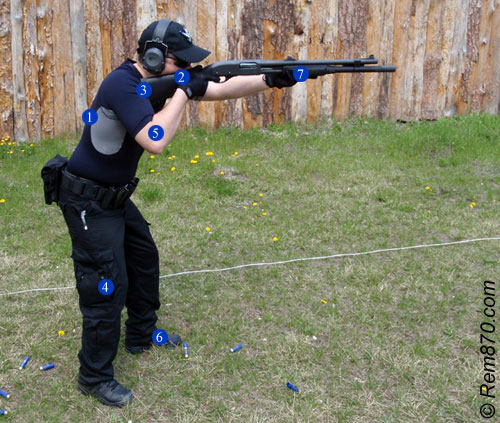
Shotgun Shooting Stance
2. Cheek weld. Put your face down on the stock. Shotgun should be placed between your eyes and target. That means that you need to learn how to put your shotgun exactly on a target when lifting it up.
3. Bring a shotgun tightly to a shoulder. If it is loose the stock will hit your shoulder shot after shot and you will come back from a range with black and blue shoulder.
4. Flex your knees, this way you will be able to control recoil with your body.
5. Don’t stick your right elbow out. Hold your elbows tucked in close to your chest. This will minimize your silhouette which is very important in home defense situation. Also, this ensures better maneuverability in close quarters environment.
6. Stand with feet about shoulder width apart.
7. Don’t put your left hand too far farward on the forend. Remeber that forend on Remington 870 located far from shooter, so you need to find a comfortable position or install a longer forend.
Practice often and you will have a proper shotgun shooting stance which will help you to shoot fast and accurately.
Please don’t hesitate to comment if you have any questions.
POLL: How often do you visit shooting range?
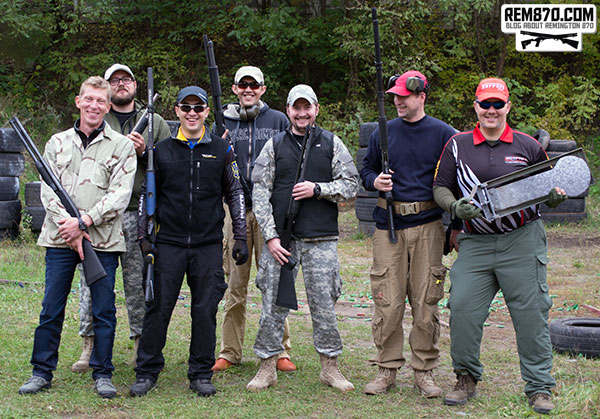
Day at the range. Have you also had fun today?
The only way to test your shotgun, accessories and skills is to visit range and shoot. Some people do it more often some people visit range rarely. How often do YOU visit shooting range?
First time on shooting range. Things to remember.
If you have never been to a shooting range before then it can seem like a pretty intimidating place. You will see lots of other people shooting their rifles, semiautomatics, and pistols with great intensity. But the thing you will notice the most are the loud noises. You may know that guns make loud noises but when you have them constantly going off it can be a little overwhelming. That is why earmuffs are always something you should remember to bring to shooting ranges. Don’t wait until you are at the firing area either. As soon as you step into the shooting range, you should have your earmuffs on to protect your ears from the loud gunfire sounds. It may also be a good idea to go with someone else more experienced at shooting ranges. That way they can assist you with the proper procedures and precautions to take while there. If you don’t have someone like this, then you can take the necessary precautions yourself.
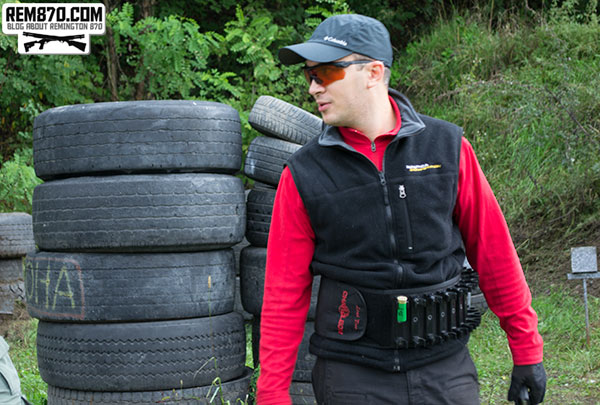
Vitaly on the Range
You have to remember that shooting ranges are not play areas. People are using real life firearms that can easily be lethal, which goes for your firearms as well. So when you go to unpack your weapons, only take out one gun at a time. Don’t lay all of your semiautomatics and pistols on a bench, especially if they are loaded. Accidents happen all the time at shooting ranges because of this kind of carelessness. All it would take is one tremor or bump into a weapon and it could go off accidentally. This is why you should only load a weapon with ammunition when you plan to use it. In other words, the one weapon you have out should be the one in your hand that you are going to shoot your target with. When you are not aiming your gun at the target, always have the gun facing downwards toward the ground. Never point a gun at something you don’t intend to shoot. This means no kidding around by pointing your gun at someone for fun. Take everything seriously.
When you have to put your weapon down on the bench, make sure you take the ammunition out of the gun and put the safety catch on. This will add extra protection in case you forget to take the ammo out or if someone else uses the gun without your permission. Finally, try not to let other people distract you. Shooting ranges are not contests, so don’t try to be perceptive of other people watching you. Nobody is going to judge you harshly for missing your target. Nobody can hit a target their first time at a shooting range anyways. It is all about practice.
Infographics: Shotgun Shooting Stance
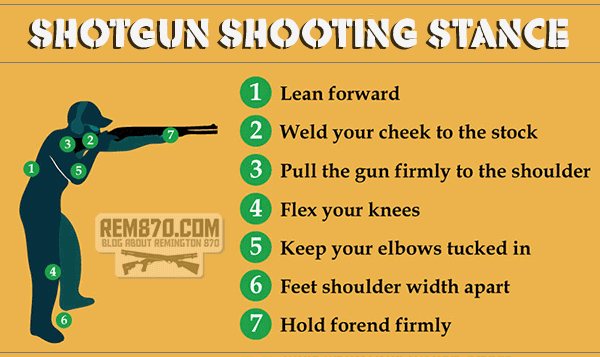
Infographics: Shotgun Shooting Stance
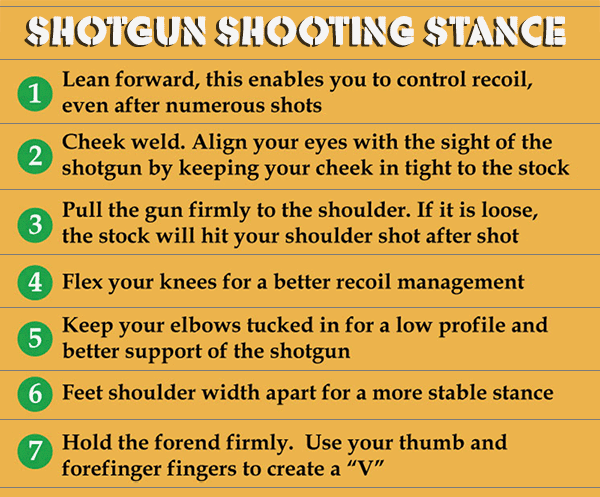
Infographics: Shotgun Shooting Stance
1. Lean forward, this enables you to control recoil, even after numerous shots.
2. Cheek weld. Align your eyes with the sight of the shotgun by keeping your cheek in tight to the stock.
3. Pull the gun firmly to the shoulder. If it is loose, the stock will hit your shoulder shot after shot.
4. Flex your knees for a better recoil management.
5. Keep your elbows tucked in for a low profile and better support of the shotgun.
6. Feet shoulder width apart for a more stable stance.
7. Hold the forend firmly. Use your thumb and forefinger fingers to create a “V”.
10 Key Skills and Metrics for Every Shooter to Test
This list isn’t complete, there are many other skills and metrics which can be added to it.
ATTENTION: Do dry fire drills only dith dummy rounds. Never use live rounds in training at home. This is very dangerous.
What can you do at range? You may shoot at targets without any plan but there are some skills that you can measure especially if you have shooting timer.
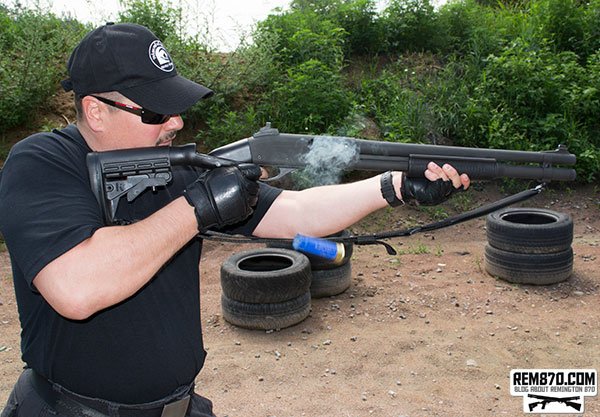
Shotgun Training Photos
1. Time of the first shot from different shooting ready positions. Hold shotgun in low ready, high ready or other positions. Try to make first shot from unloaded shotgun or shotgun with epmty chamber. It is extremely important to be able to make first shot fast and accurately.
2. Tactical reload time. Tactical reload is usually done using the cover and when you have round in a chamber. You load rounds into a magazine tube. Try reloading on the move, kneeling. Try not looking on a shotgun when you make reloads, look at the targets. Measure time you need to load rounds into a magazine tube.
Remember that empty shotgun is as useful as a piece of metal.
3. Time of the two fast shots. How fast can you make to accurate shots? Especially with your pump shotgun?
4. Running from one position into another. How fast can you move to a position, shoulder a shotgun, aim and make a shot?
5. Time of transition from one position into another. How fast can you go from standing into a kneeling? From standing into a prone? From kneeling into an urban prone?
6. Time of the transition from closer target to a further target from target on the far left to target on the far right.
7. Movements, run and gun and other drills.
8. Shoot at targets with “hostages”. It is important to train fast and accurate shots.
9. Rapid shooting. Try shooting at groups of targets.
10. Emergency reload is when your shotgun is completely empty and you need to load a round into a chamber first. Measure time you need to load a round into a chamber and make a shot.
Common Shotgun Shooting Mistakes Video
Small but very useful video with the most common shotgun shooting mistakes…
General Shooting Advices
There is no question that the gun culture exists heavily in America. Besides people’s love for their Second Amendment rights, they simply love to shoot for fun at their local shooting range. Some people even like to go out into the woods and exercise their right to hunt animals for sport. But there are still advices that people should follow if they are ever going to shoot a gun, whether it is at the range or in the woods. The first piece of advice is to never point a gun at anything that you don’t intend to shoot. It doesn’t even matter if you have a loaded gun or not. Sometimes you might not think there is ammunition in the chamber, but then you pull the trigger for fun and find out that it really was loaded for whatever reason. So never point your gun at anybody as a joke because the results may not be as funny.
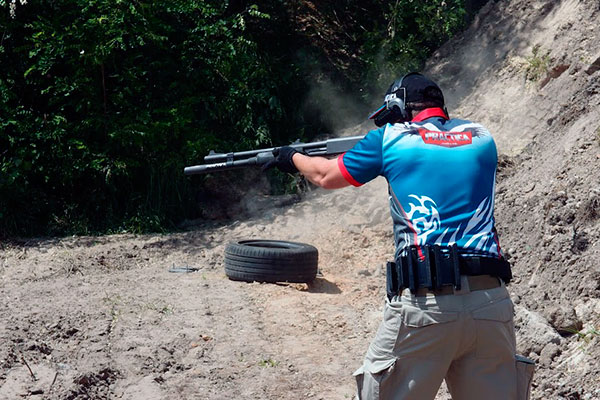
Shotgun Instructor
Another general piece of advice is to empty your gun’s chamber of ammo after you are done using it. People make the mistake of keeping their guns loaded when they are not using them, but this can be dangerous if children are around. That is why you often hear in the news about children finding their parent’s gun and shooting themselves or another person. They could accidentally find a weapon in their mother’s purse or under their father’s bed and think it is a toy. Then they point it at someone and pull the trigger without realizing the deadly consequences it will bring. Now you may think it is necessary to keep a loaded gun in the house in case burglars or intruders break in. But really, how long does it take for you to load a weapon with ammo? If you stash a loaded magazine (for handguns) or belt with shells (for shotgun) somewhere secure then you can just load the gun within seconds. This is the safest way to go about keeping a gun in the house with children around.
New shooters often try to be cool by shooting their pistols with one hand, but the recoil could end up pushing them to the ground. That is why you should always use two hands when firing any kind of firearm, especially a pistol.
And as always, wear earmuffs or earplugs at the shooting range to avoid going deaf. And don’t forget about eye protection.
Tactical Shotgun Course
Organized Tactical Shotgun Course. Things students liked the most: targets with t-shirts, smoke, moving targets, penetration test (used 4 sheets of sheetrock), shooting on the move, slug change over drill.
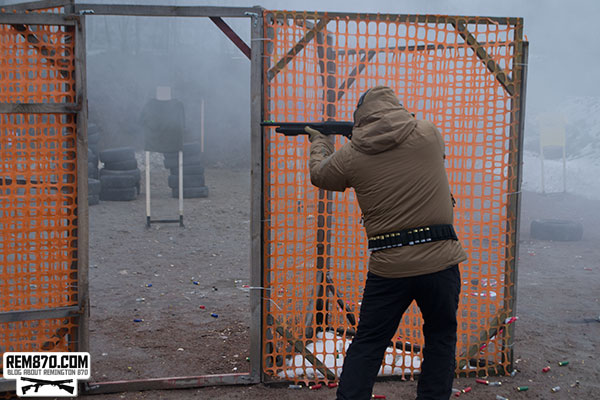
Tactica Shotgun Course
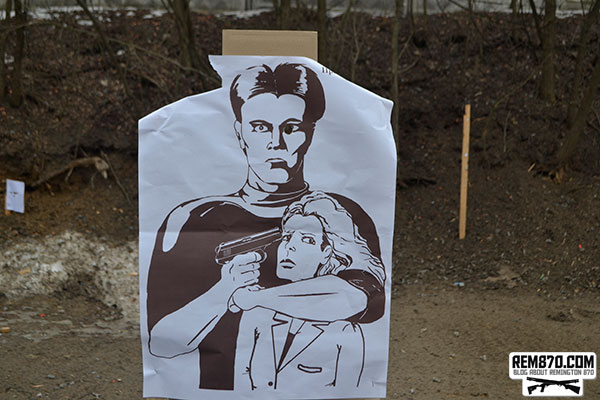
Target with Hostage
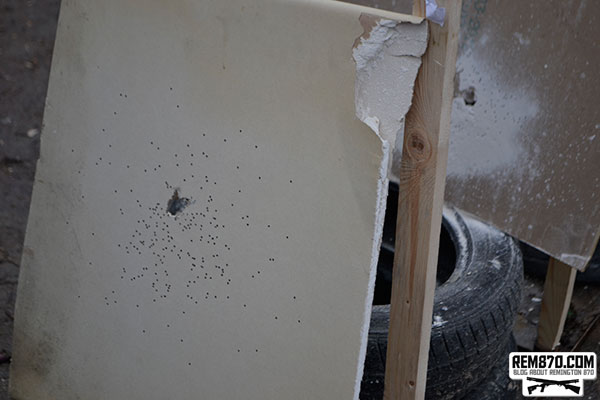
Sheetrock Penetration Test
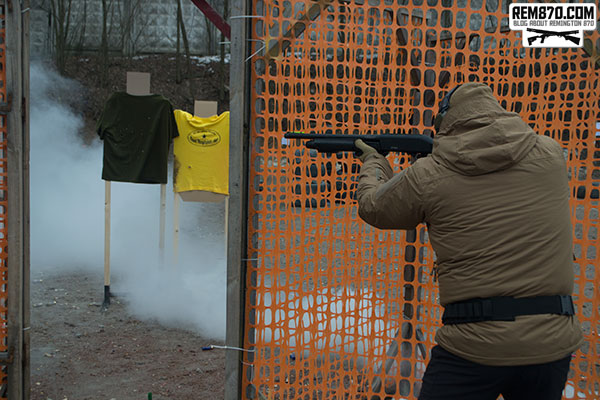
Tactica Shotgun Course
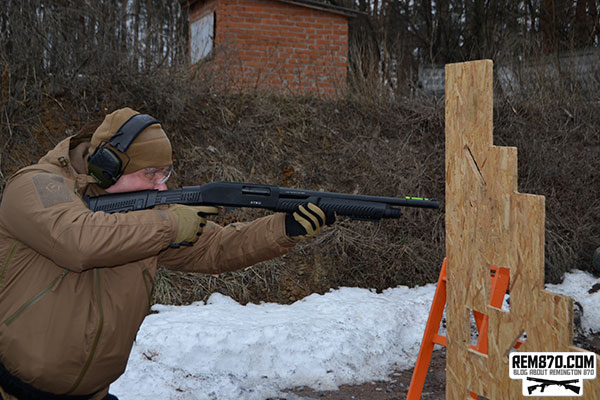
Tactica Shotgun Course
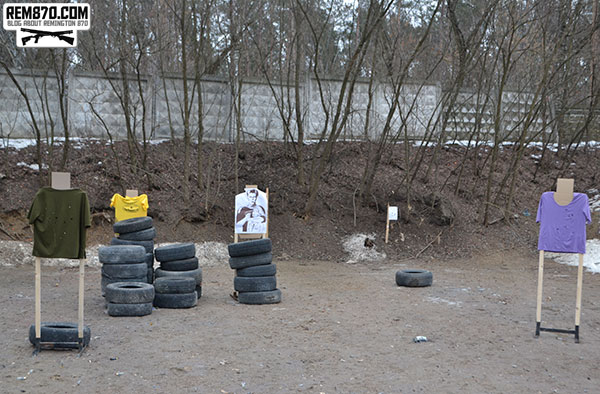
Targets in T-Shirts
Advices when shooting on the move
There are not too many situations where you will be shooting on the move. Chances are if you are at the shooting range or you go hunting in the woods, you will be in a static standing position when you go to shoot your weapon at the desired target. The only people who will be shooting on the move are police officers, or crooks. But hey, this is not advice for crooks. Police officers or those thinking about becoming police officers need to follow certain advice in order to shoot properly while on the move.
Shooting on the move generally means shooting while in a moving vehicle. If you are the one driving the vehicle then you definitely shouldn’t be the one doing the shooting. Your concentration must be on the road at all times, especially since the situation is likely requiring you to drive fast and maneuver around other cars. Hopefully you have somebody else in the car with you that can do the shooting, such as your partner. Now if you happen to be the passenger in the car and you have to do the shooting, then here are a couple of tips. Always secure your lower body whenever possible. A moving vehicle can be extremely bumpy and it will move you around quite a bit. Since you will likely be going fast in any situation where you have to shoot on the move, expect to get tossed around a lot in the car. Therefore don’t stick your upper torso out the window and shoot somebody like you see in the movies. Try to stay in a seated position with your seatbelt on at all times. Next you will only want to shoot from the side of your window. Don’t try to shoot in front or behind the car because your aim will be off and you could increase the chances of injuring a pedestrian.
For anyone who wants to shoot while they are walking or jogging, your aim is definitely going to be off because you won’t be evenly aligned with your target. The best advice is to train at shooting on the move in your spare time. This isn’t something you are going to master if you do it in the spare of the moment. You have to train on being alert of what is around you and what is on the ground. The last thing you want to do is shoot as you run and then end up tripping over a branch as you keep shooting. This could result in you shooting yourself if you involuntarily shoot as you are falling to the ground. So try to scope out what is around you before you make the decision to shooting while moving. Then just follow basic shooting advice like keeping good shooting stance and pointing gun far away from your body. Also, don’t go start shooting fast like a mad person. Try to do single shots that are calculated. That way you won’t get carried away and make a mistake.
Shotgun Training Photos (Pump-Action, Semi-Autos, Benelli, Remington)
Photos from shotgun training last week end:
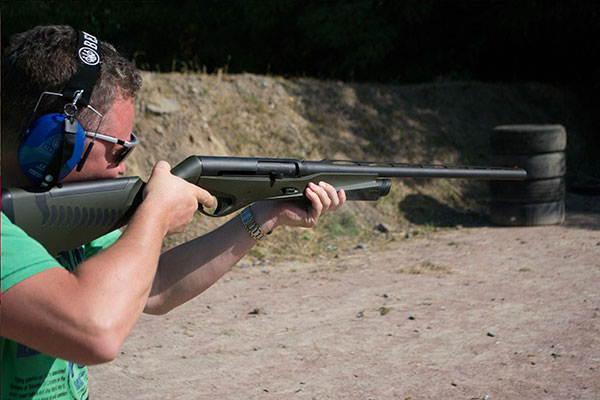
Shotgun Training
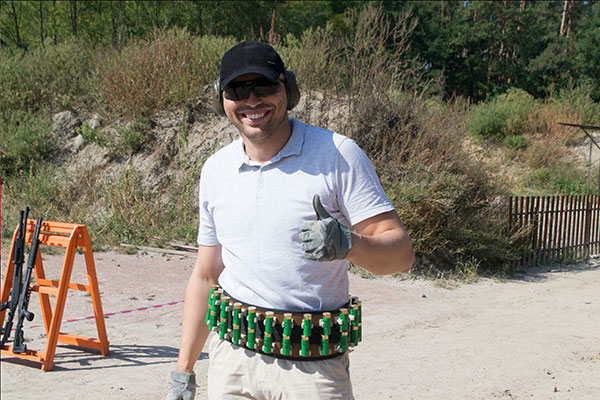
Shotgun Training
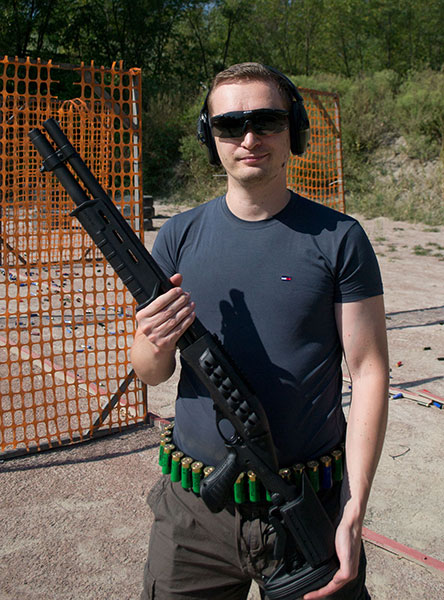
Shotgun Training
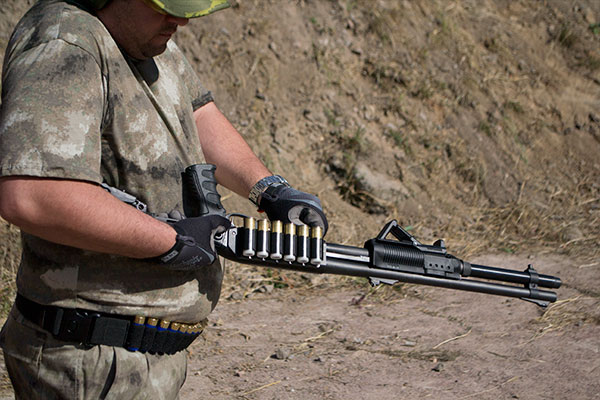
Shotgun Training
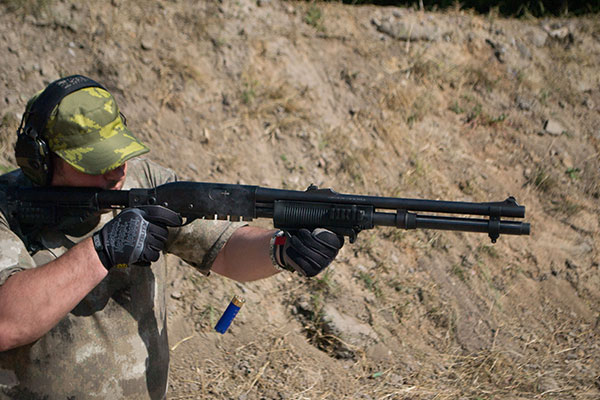
Shotgun Training
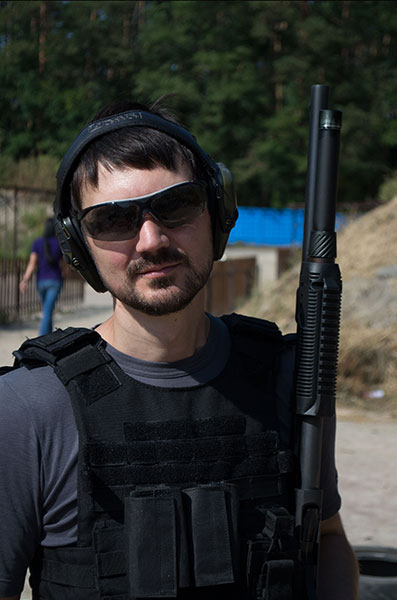
Shotgun Training
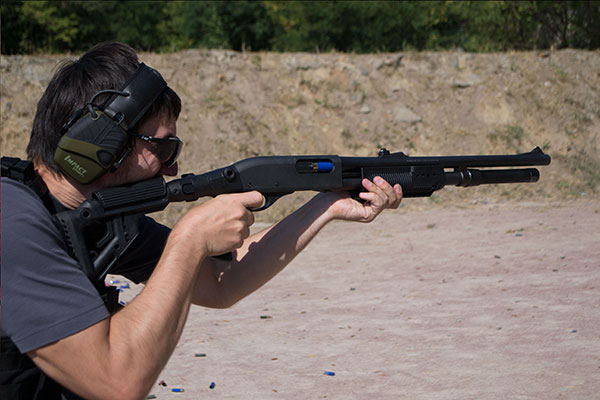
Shotgun Training
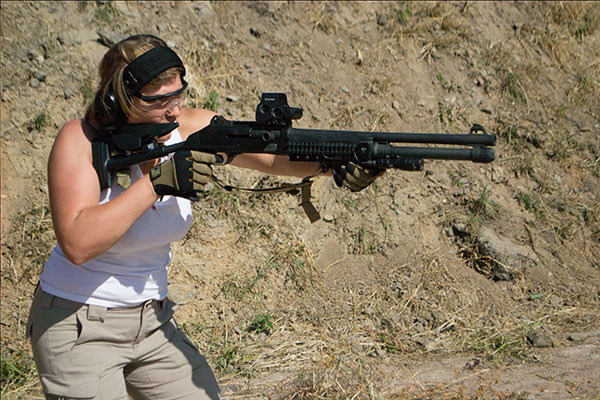
Shotgun Training
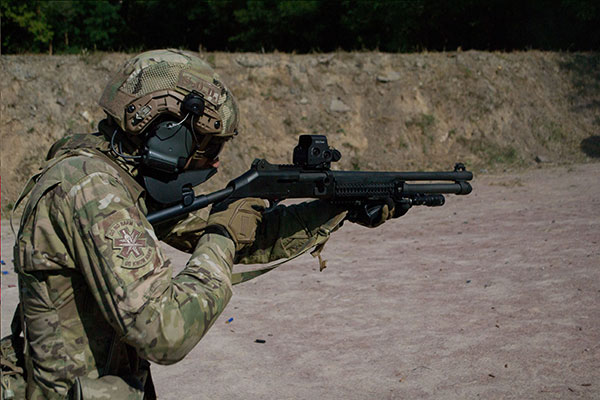
Shotgun Training
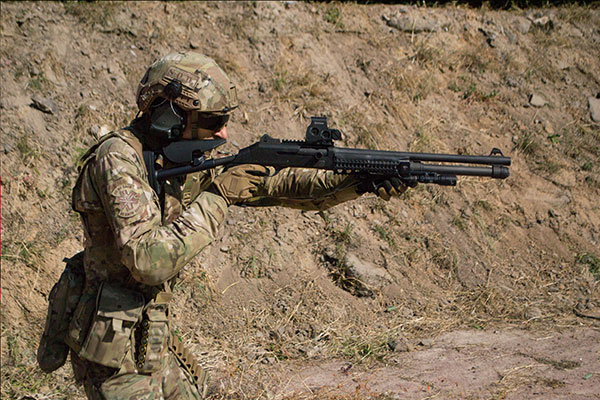
Shotgun Training
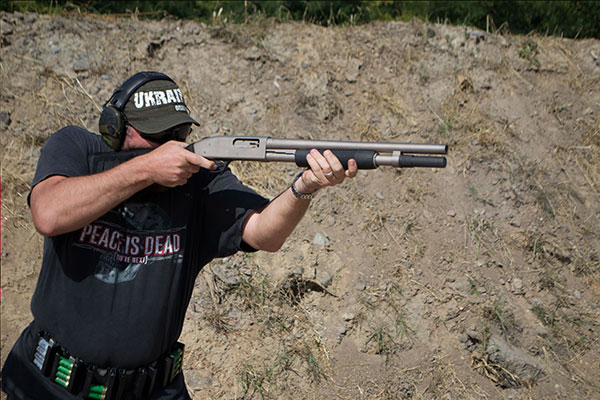
Shotgun Training
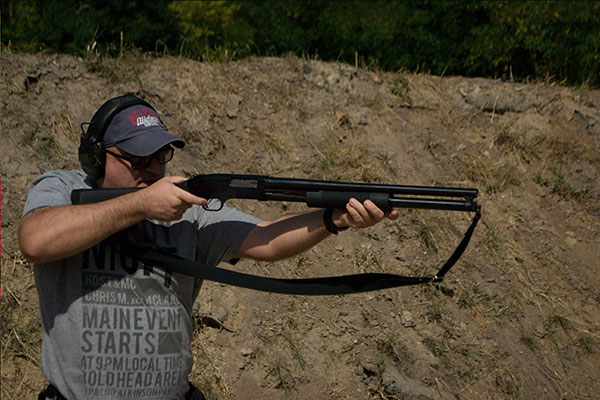
Shotgun Training
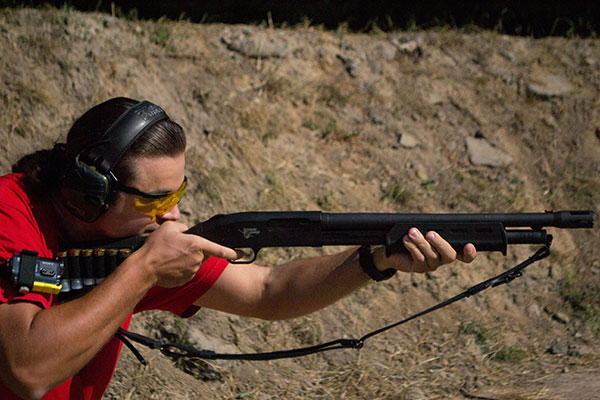
Shotgun Training
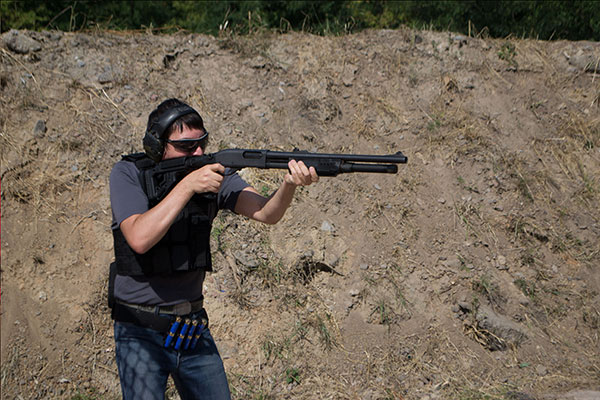
Shotgun Training
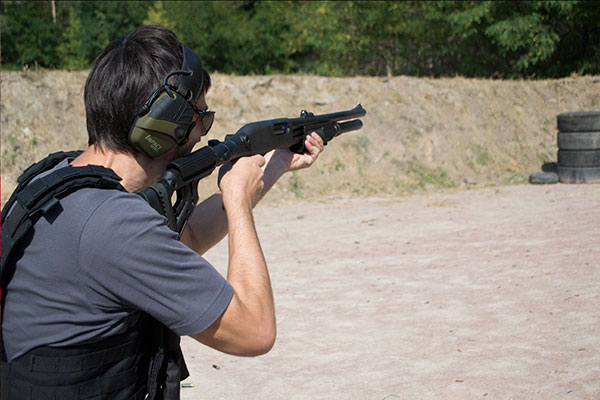
Shotgun Training
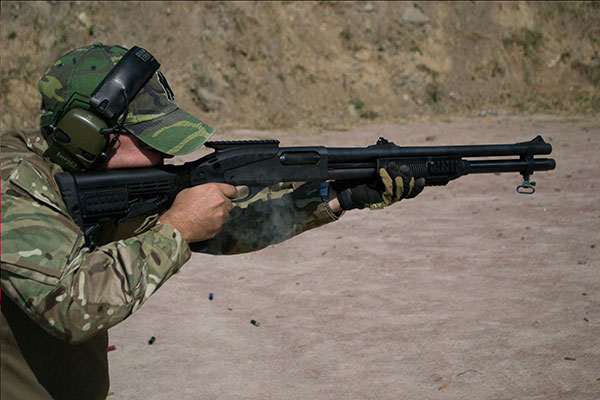
Shotgun Training
What to take with you to a shooting range? List of equipment
Gun owners typically frequent their local shooting range in order to practice their aim with a gun. The only other place you could practice is the woods, but not all of us our fortunate to live near them. Shooting ranges have their advantages though because you get to shoot at a target that resembles a human being. This will help you practice your aim in real life situations where you might have to shoot an attacker or intruder.
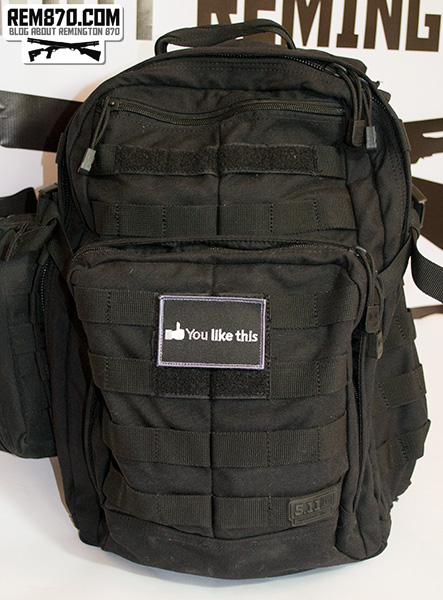
5.11 Tactical RUSH 12 Backpack Review
When you go to the shooting range you need to take a few accessories with you. Of course, the main items you will bring are the guns you plan to shoot at the shooting range. Make sure you pack enough ammunition for each gun as well. It is common for people to forget how quickly ammunition gets used up when you fire a weapon. Some shooting ranges may sell ammunition, but don’t count on it because they may not sell the right ammunition for your weapon. You also don’t want to depend on buying ear protection at a shooting range either. It is important to bring an extra supply of earplugs or earmuffs with you to the shooting range because you will literally be surrounded by gunfire. If you were to go there without any ear protection then you could go deaf for weeks. For those who are new to shooting ranges, you should purchase electronic earmuffs because they are the easiest to wear and they also allow you to communicate with people without taking them off.
Eye protection is another important thing you want to consider, which is often overlooked by novice shooters. There is always a chance of debris flying in the air from the target. If you don’t have proper eye protection then you could risk eye injury if the debris hits your eyes. Again, some shooting ranges may sell shooting glasses but take some with you just in case they don’t. You should also bring your own targets for the same reason. You can buy targets online at a number of shooting gear websites or secondhand websites, like eBay. Then finally, you will want duffel bags to carry around all of your guns and accessories. If you are shooting anything bigger than a pistol, such as a rifle, then get a long bag to cover it. This way you keep it clean as you walk around the shooting range.
Tactical Shotgun Training
Photos from recent 2-day shotgun training.
Topics covered:
Ammunition
Safety rules
Basic stance, loading, unloading
Buckshot pattern
Shooting from the hip
Kneeling position
Prone position
How to shoot pump fast
Slug shooting
Shooting at targets close to hostage
Imitation of a building with 3d targets
Shooting from left shoulder
Shooting from difficult positions
Shooting on the move
Search And Assess drills
Home defense advices
Dry fire drills advices
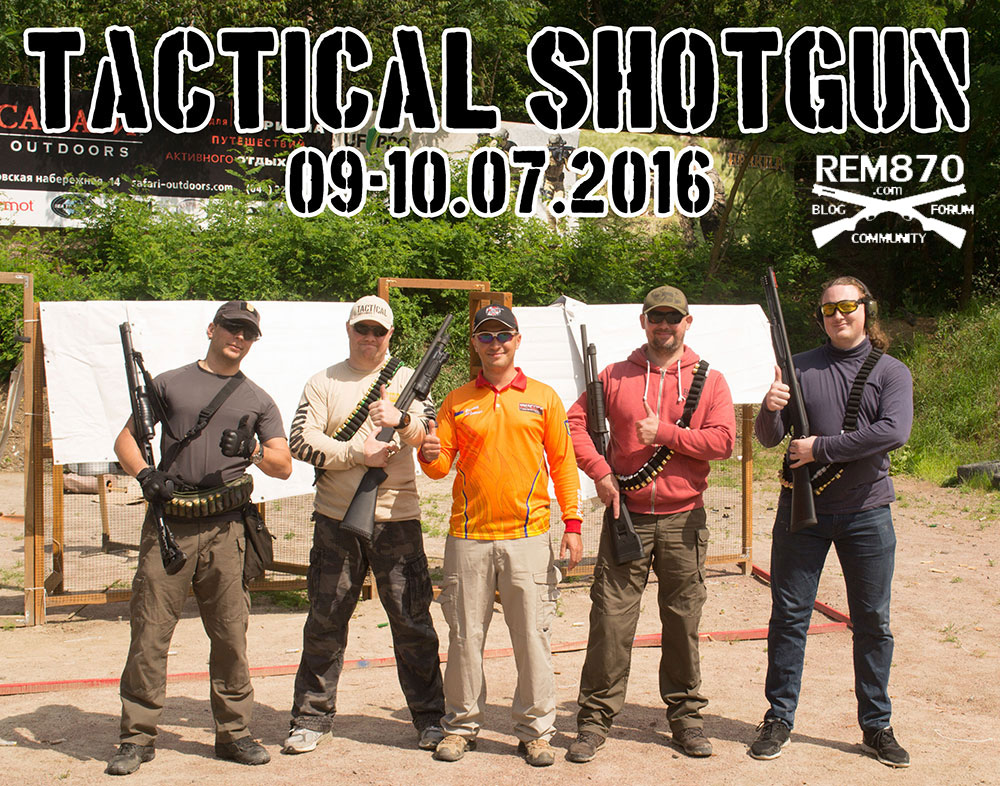
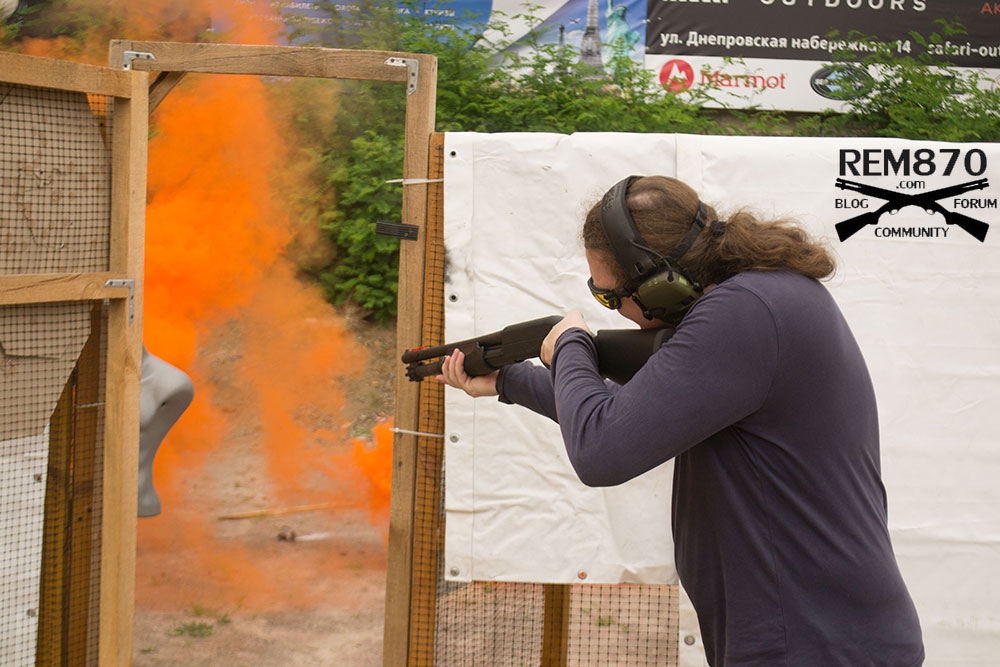
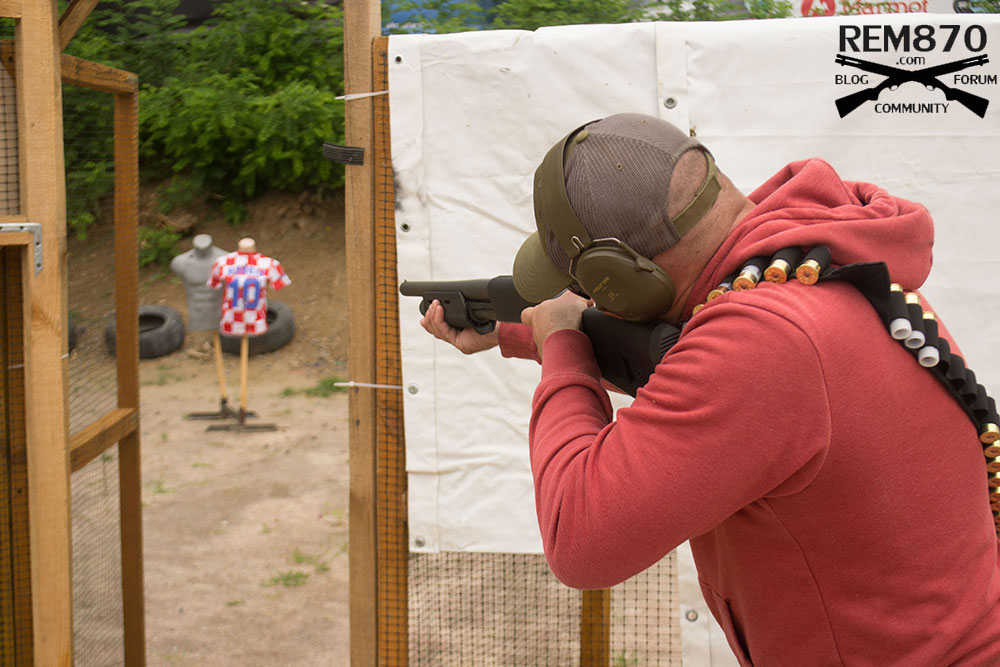
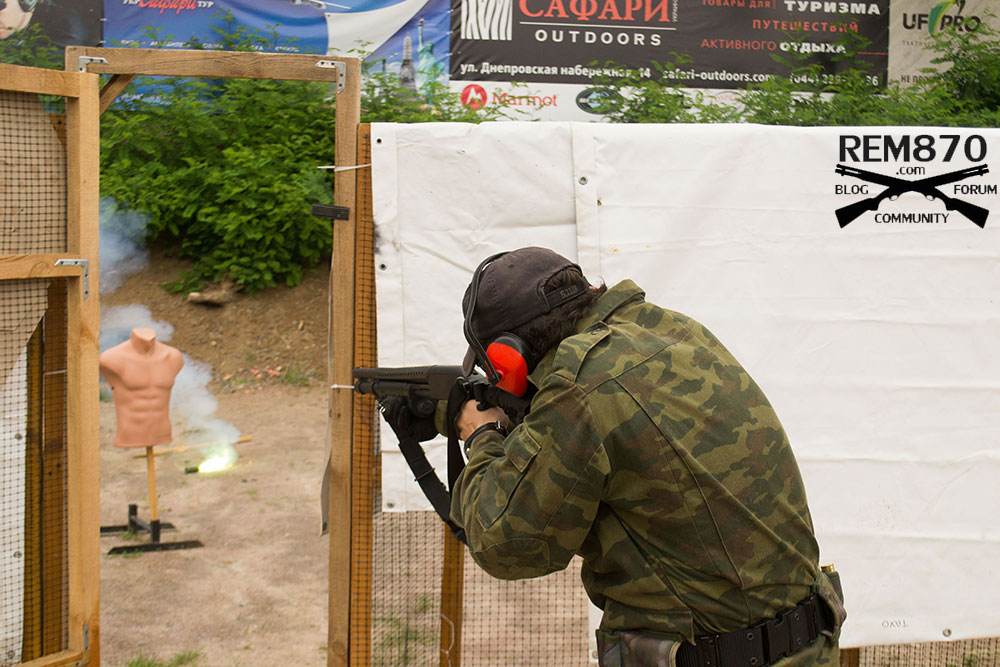
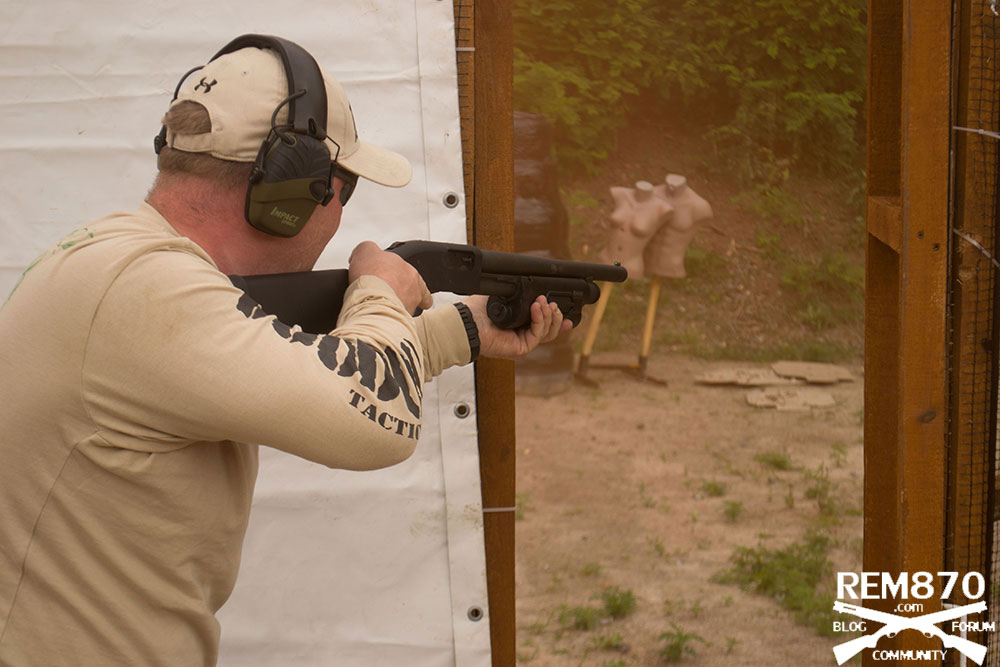
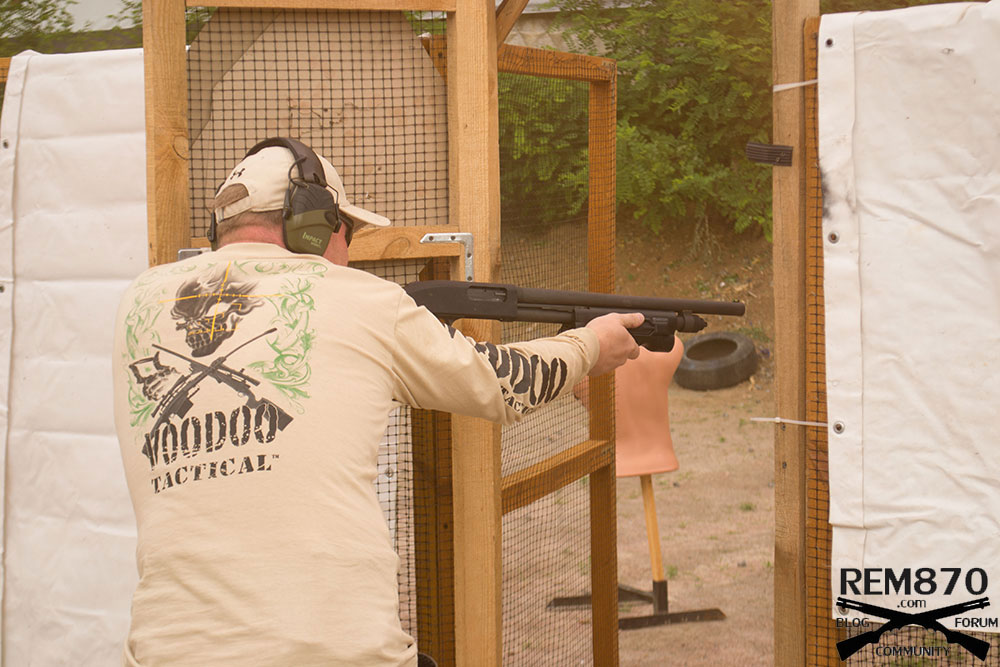
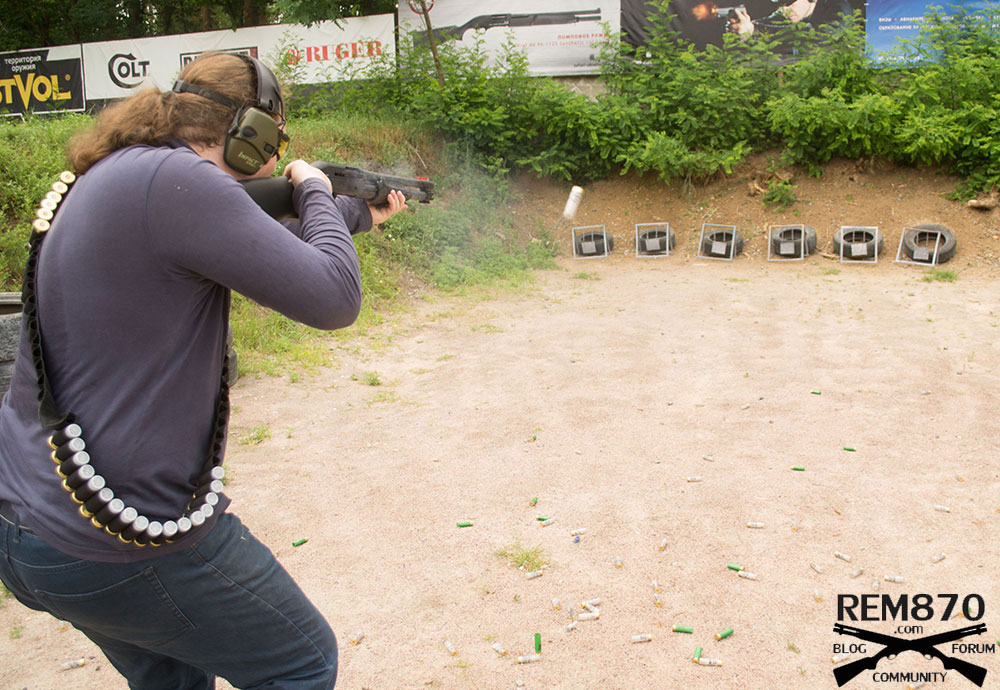
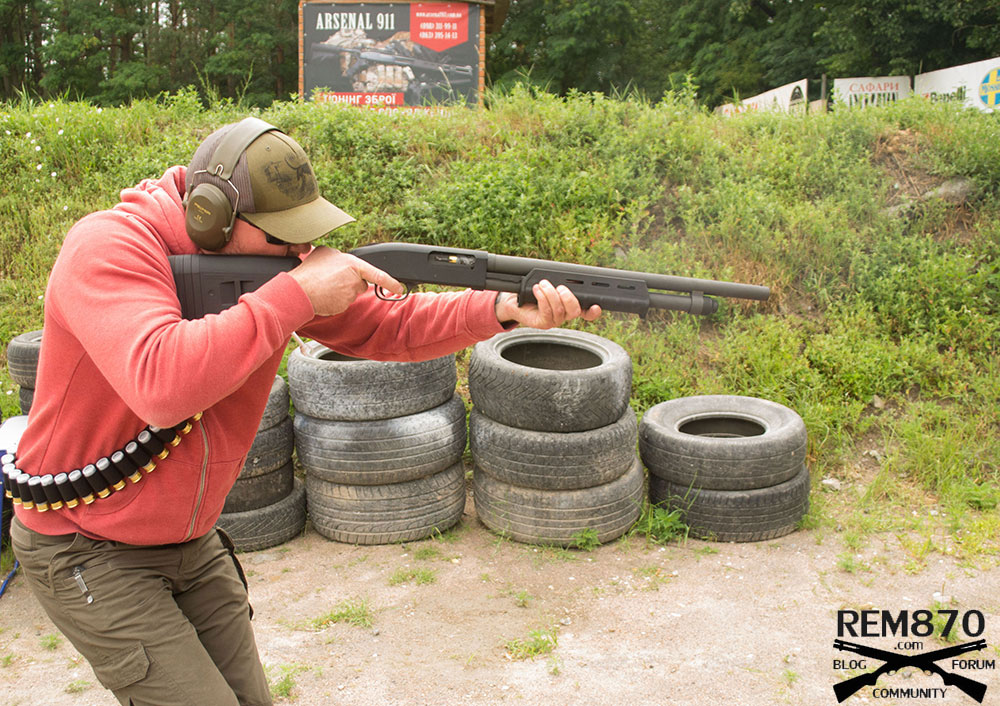
Angle Opening Seeing Around Corners
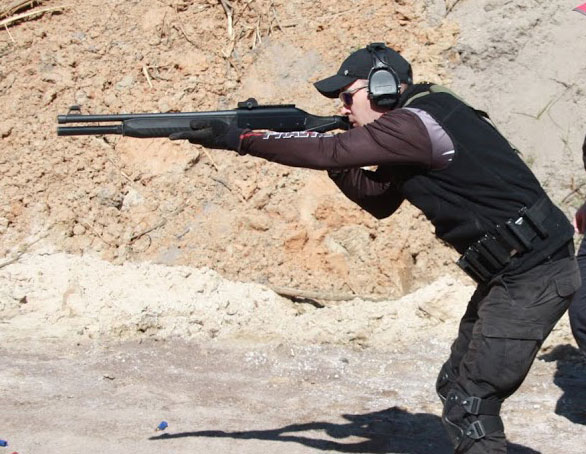
Tactical Shotgun Training Today
To hit a target you have to acquire that target, which is typically called target acquisition. Shooting blindly or fanning a weapon only wastes ammunition and can cause collateral damage. Firefights are not typically staged unless they are in Hollywood. Once in a firefight you have to deal with the situation, and that usually means limited cover/concealment, poor light conditions and numerous obstacles that obstruct your field of fire/line of sight and in particular, corners are a dangerous obstacle.
Corners are dangerous intersections in a firefight because you usually do not know what is around them but you have to assume an assailant is, and they need to be engaged to stop them. There are ways of looking around a corner, to include small mirrors, pinhead camera lenses on small probes and special gun sights that allow you to view different angles from cover.
Once you know what is around the corner you still have to expose yourself somewhat to engage the shooter or assailant. The spray and pray technique will expose you and you want to be assured of what you are shooting at before you step around the corner. There are mirrors that can be rail mounted on weapons and the only thing exposed when using the mirrors would be the weapon’s muzzle.
From the depictions it is assumed you could also fire from this position, and once again, the only part exposed are the weapon and possibly your hands. Of course, you will draw fire from a shooter so it will take hours of practice to master the use of this device so you can acquire your target then fire and maintain cover in just a few seconds. A few well placed shots and your weapon and hands are disabled if the other shooter is paying attention.
Practice and having the ability to shoot accurately from either shoulder is important in overcoming corners. In a home defense situation, you may not have technology to help you. If your right shoulder were to the wall, you would have to fire from the left shoulder around the corner and of course, if your left shoulder is to the wall you fire from the right shoulder. You cannot step from around the corner you will have to switch shooting hands to avoid exposing more of your body than is necessary.
Getting in the prone position to “peek” around the corner is usually not recommended because it will take you to long to gain your feet if you have to move. Experienced shooters will always look for shooters to do this move around corners.
The movies usually show people jumping out from behind corners and facing the hallways and the assailants always seem to be surprised. In real firefights, the other shooters may not be surprised at all and in fact may be waiting for you pull such a dangerous move.
One of the many things you have to concentrate during tactical maneuvers is intelligence gathering. You need information, so using whatever means you have available you have to locate and acquire targets in a shooting situation.
If you have to move from around a corner do it in a crouch and be ready to fire. Go down to one knee if you have to get below the line of fire. Your assailants will be standing and will usually fire where they assume the shooter is standing, this means they may fire over you. It will take the shooter a split second to realize you are crouched or on one knee.
Shotgun for Home Defense Training
Shotgun for Home Defense Training this week end, it was great, had 17 students.
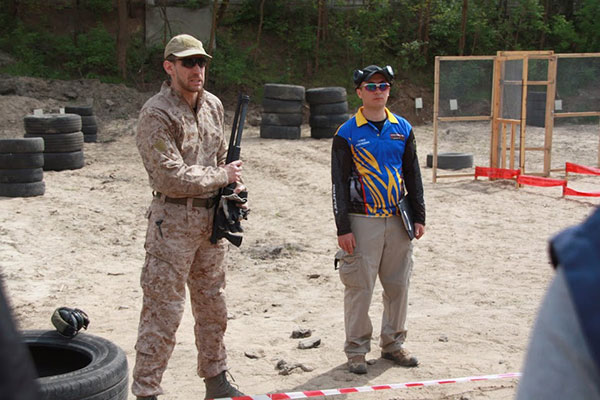
Shotgun for Home Defense Training
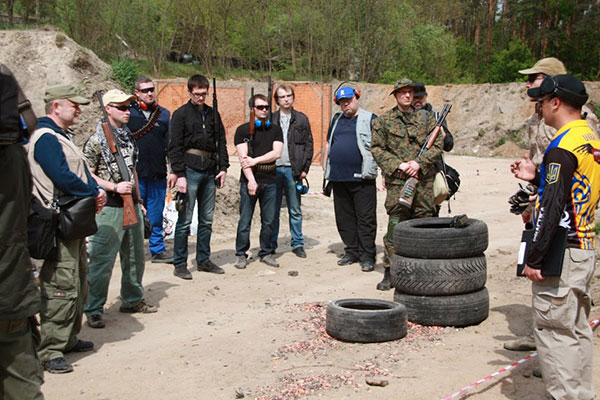
Shotgun for Home Defense Training
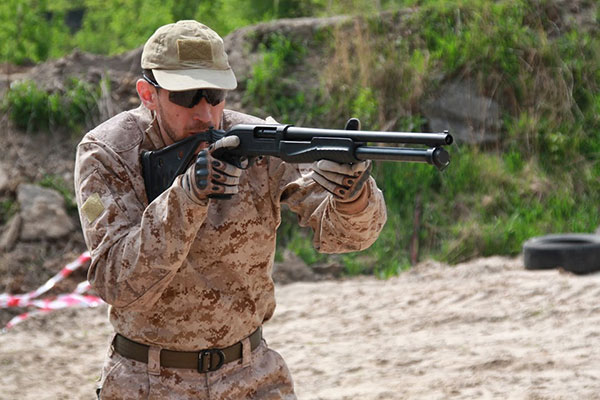
Shotgun for Home Defense Training
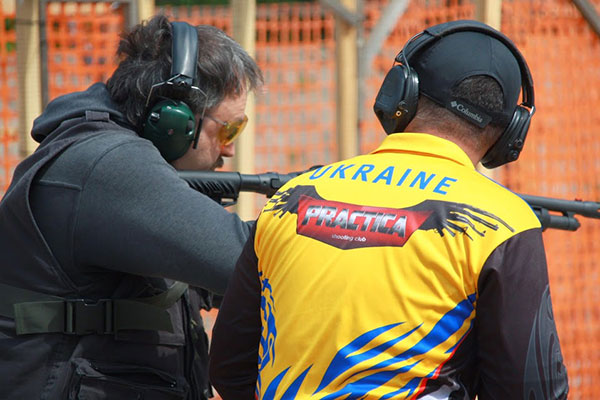
Shotgun for Home Defense Training
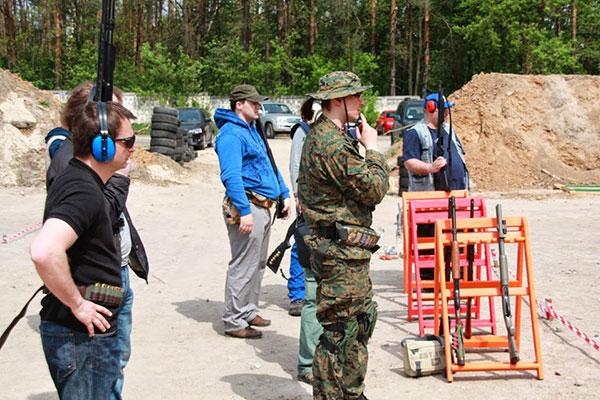
Shotgun for Home Defense Training
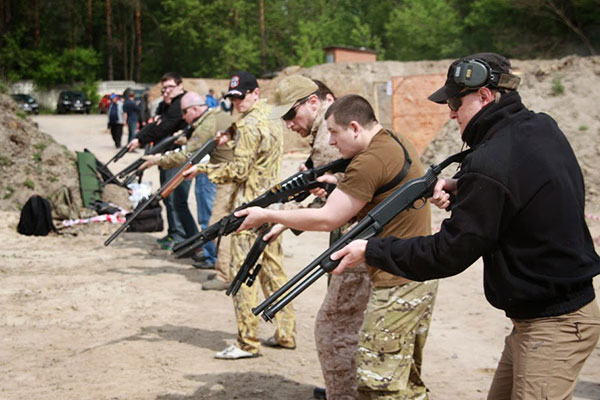
Shotgun for Home Defense Training
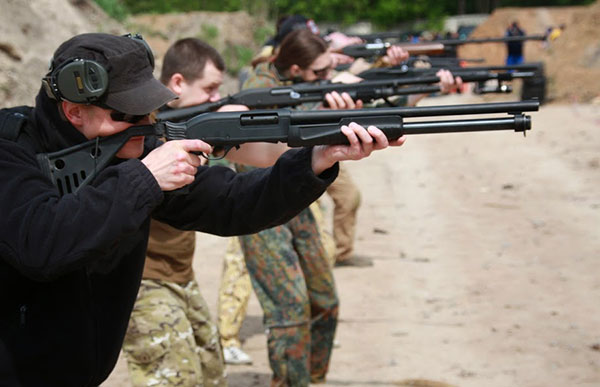
Shotgun for Home Defense Training
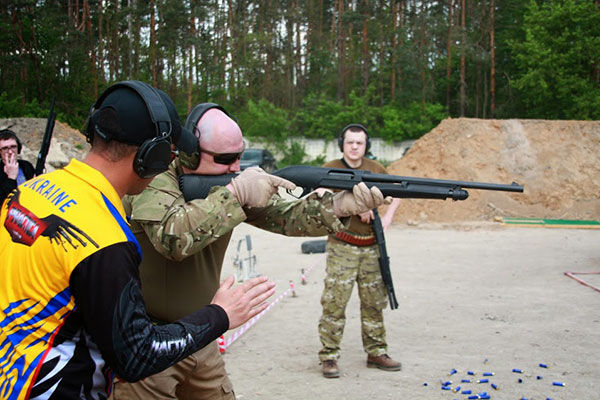
Shotgun for Home Defense Training
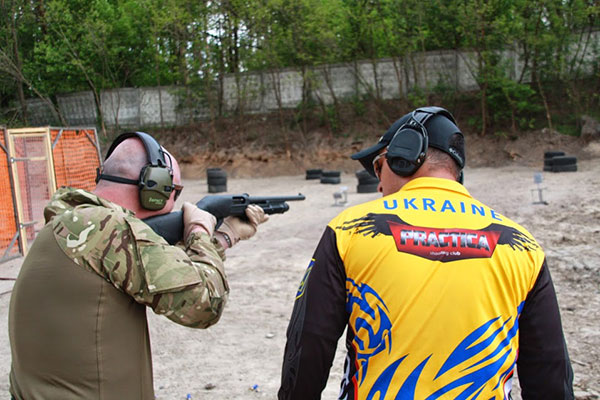
Shotgun for Home Defense Training
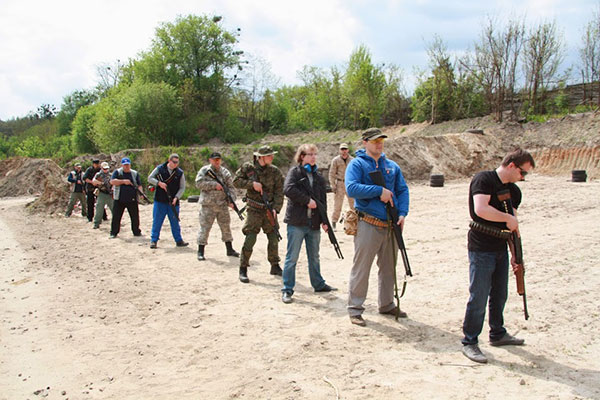
Shotgun for Home Defense Training
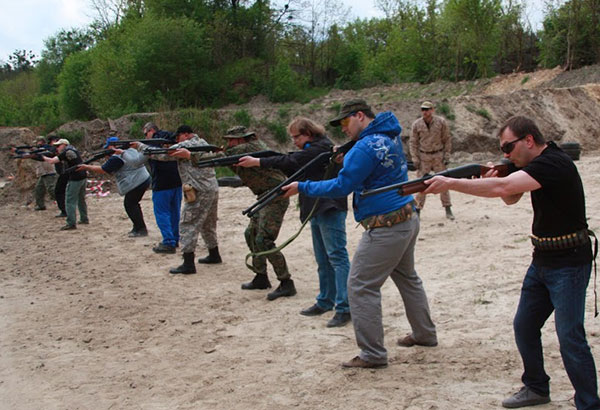
Shotgun for Home Defense Training
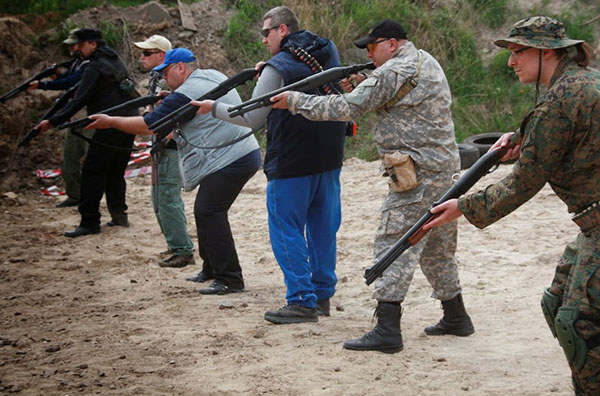
Shotgun for Home Defense Training
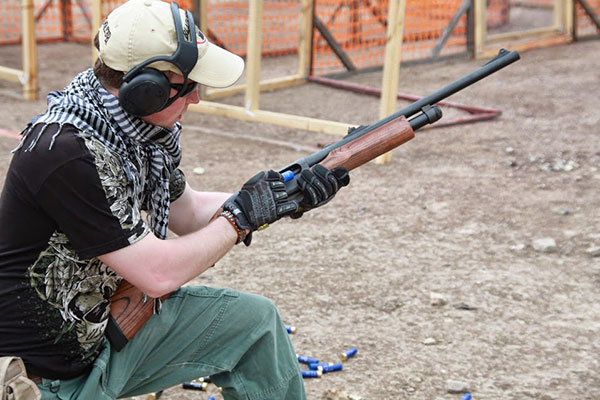
Shotgun for Home Defense Training
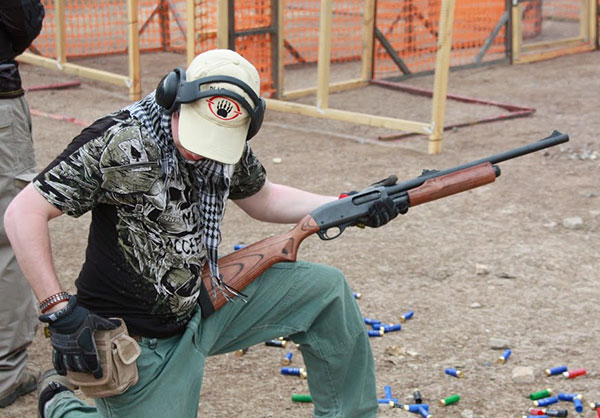
Shotgun for Home Defense Training
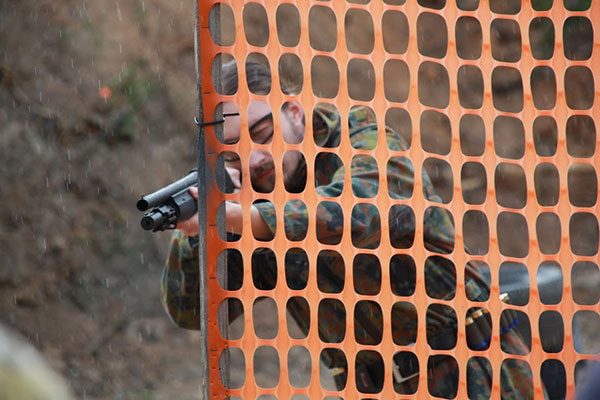
Shotgun for Home Defense Training
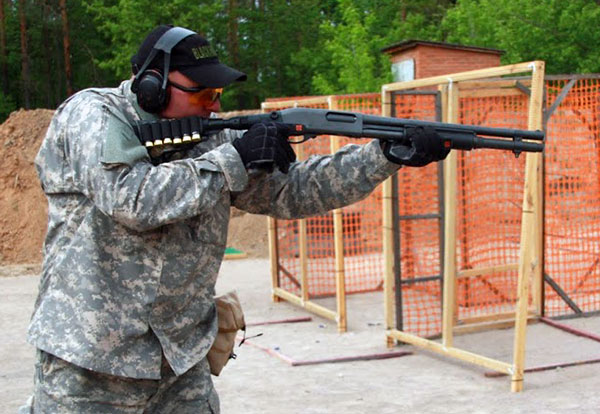
Shotgun for Home Defense Training
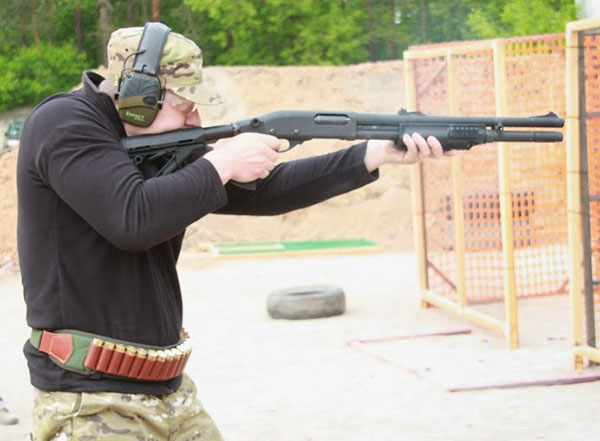
Shotgun for Home Defense Training
Tactical Shotgun Training Photos
I work as shotgun instructor in local shooting club. This time I organized 2-day training called “Tactical shotgun”.
Things that were covered during this training:
1. Firearms safety
2. Types of shotgun ammunition, what and where to use
3. Eye and ear protection
4. Shotgun ammo reloading
5. Cleaning, lubrication, mainitenance
6. Shotgun accessories
7. Shotgun shooting stance, recoil mitigation
8. Shotgun ready positions
9. Emergency loads and tactical loads
10. Buckshot pattern
11. Slugs at short, medium and long distances
12. Targts close to hostages
13. Home defense drills
14. Shooting from the weak shoulder
15. Fast follow up shots
16. Shooting from different positions, knee, prone.
17. Penetration test
18. Ricochet test
19. Shooting from the hip
20. Shooting on the move
21. Different drills

Tactical Shotgun Training Photos
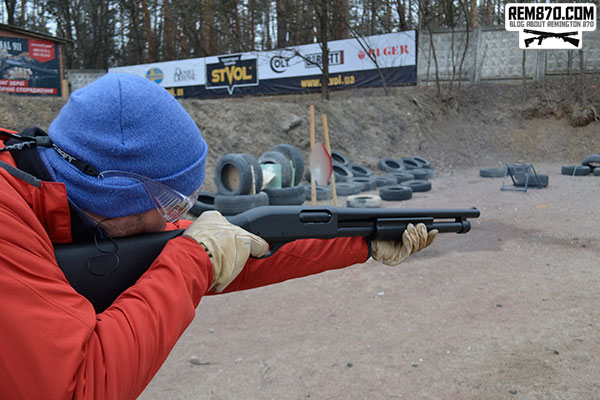
Tactical Shotgun Training Photos
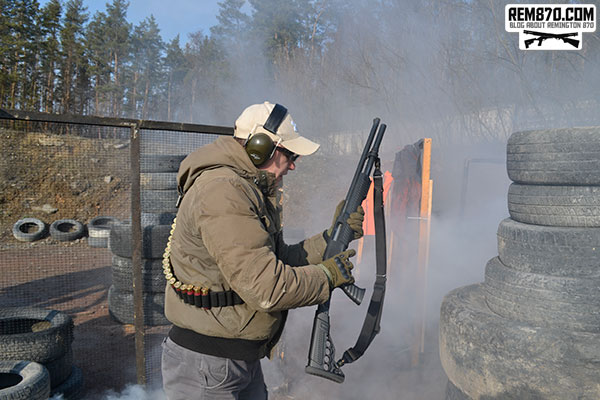
Tactical Shotgun Training Photos
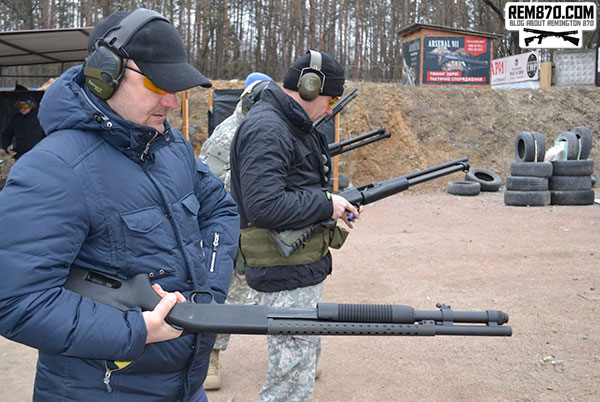
Tactical Shotgun Training Photos
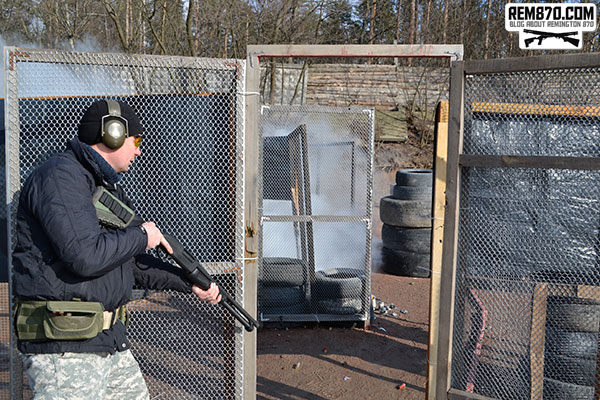
Tactical Shotgun Training Photos
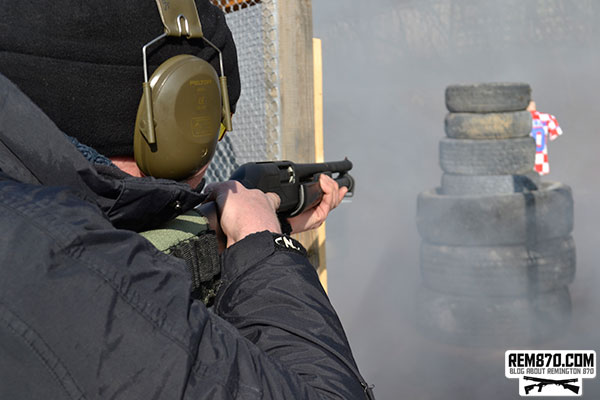
Tactical Shotgun Training Photos
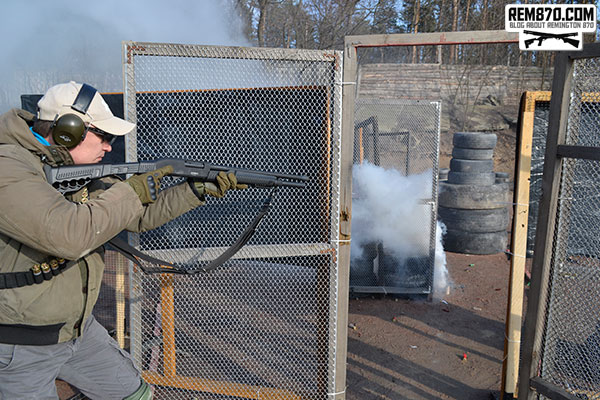
Tactical Shotgun Training Photos
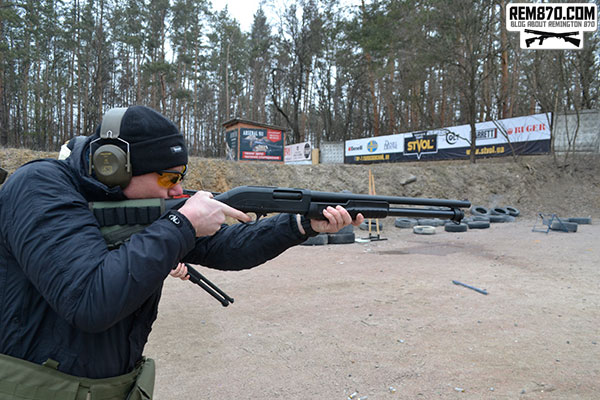
Tactical Shotgun Training Photos
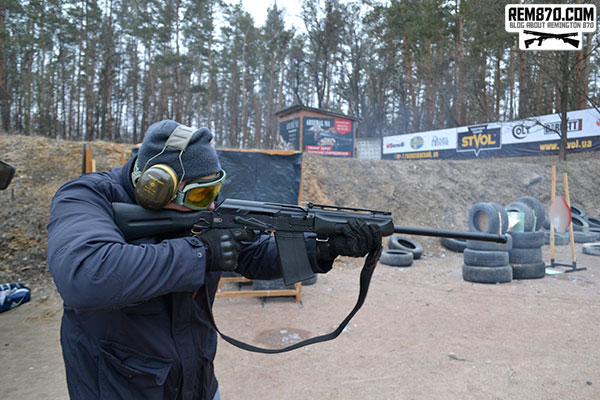
Tactical Shotgun Training Photos
Practical Shotgun Course
Took a lot of time but I finally organized Practical Shotgun Training Course consisting of 10 trainings. There were 2 groups of 6 students each.
We started from basic things like shotgun stance and finished with all the students knowing how to shoot on the move.
Course program:
1. Gun Safety Rules
2. Equipment.
3. Warm-up drills.
4. Dry fire drills.
5. Basic shotgun shooting stance. Drills to check and improve stance.
6. Transitions. Proper eye work.
7. Wide transitions.
8. Movement with shotgun. Different directions, correct start and stop.
9. Buckshot patterning.
10. Slug shooting up to 40 meters.
11. Shooting on the move.
12. Transitions.
13. Proper pump-action shotgun manipulations and shooting.
14. Fast pump shooting.
15. Practical shooting drills.
16. Penalty targets.
Each shooter had about 250 rounds per training. That may sound a lot but with proper program it is not that difficult. Also, I have hired helpers which were restoring the targets, that made training faster and students were not required to spend time and efforts on that.
The most popular shotgun of the course was Remington 870. It is not a surprise because 870 is extremely reliable. It became really popular in Practical Shooting during recent years. It requires some work, modifications and preparation for practical shooting but then it enables shooter to load and shoot shotgun fast.
The silver medal of the IPSC Shotgun World Shoot 2018 got shooter with Remington 870.
I have many articles about required modifications and upgrades and they are not only for sports. They improve reliability of our favourite shotgun. There are some inexpensive small parts which can dramatically improve your experience with 870. Small things like extractor and carrier latch spring will cost almost nothing but will fix many possible issues.
Hot tea helps to stay warm during cold winter days. We were lucky to have good weather during almost all of the training days. Now everyone wants second Practical Shotgun Course and I am preparing it. Competitions start very soon, so we need to get as much training as possible.
Ready to Shoot Positions
A ready to shoot position may mean different things to different people and a lot has to do with your training. Where you are at may also change the meaning. One ready to shoot position is where the safety is on and your finger is along the trigger guard and not inside. The weapon is pointed in the direction of expected fire or pointed slightly up or down, but not down to the point where your feet would be in the line of fire. Once the target is spotted or the command for fire is given take the safety off as you bring the weapon to bear on target, sight and depress the trigger.
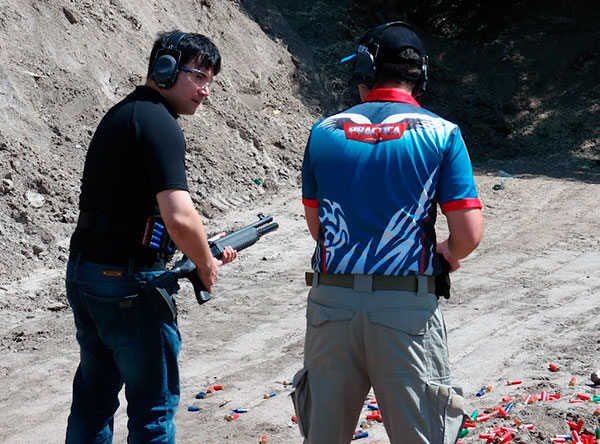
Vitaly Pedchenko, Shotgun Instructor
When holding a shotgun in the ready to fire position ensure the stock is above any holstered weapon or ammunition pouches on your hip. The low ready position is one of the more complicated ones because it is used in close quarter combat and is sometimes called the “inside position” in reference to home defense. You are in closed quarters and having the weapon pointed out away from the body may mean it strikes obstructions as you clear rooms or even gives the aggressor the opportunity to grab the barrel.
The low ready position is where the weapon is pointed to the ground and the body is slightly bent. In close quarters, this keep the weapon’s muzzle from hitting objects and it also keeps you from firing prematurely. In home, defense this is important to prevent accidentally shooting other family members. The weak hand is on the forearm of the shotgun. Have the back of the hand in contact with the thigh. It would be the left thigh if you shoot right handed. This provides support for the weapon and shooting hand. You can move in this position but do not advance on an aggressor unless you raise the weapon and disengage the safety.
The low ready position is used when there is not a clear threat identified. The weapon is usually pointed to the ground. Remember you need a clear field of view and peering along the sights does not give you that view so until a target is identified keep the muzzle low, where the shotgun does not obstruct your view. It is always faster to bring a weapon up into the right position than trying to bring one down, you inevitably have to reposition if bringing weapon down because gravity will lower it beyond where you need it.
You can be blocked from shooting if the gun is raised high whereas if someone attempts to block or take your weapon as you bring it up you only have to pull the trigger. The gun in the low ready position is ideal for moving through tight quarters. This position also makes it easier to keep the weapon and your eyes pointed in the same direction by shifting your hands and body slightly. You have seen the movies where the shooter has the gun pointed up by their ears and they are looking in the opposite direction. You want the muzzle pointed where you are looking.
Basic Rifle Shooting Course
Participated in basic rifle shooting course. Topics which were discussed: ballistics, shooting stance, transitions, magazine changes, double tap. I was using my AKM (AK-47 mod) but there were a lot of participants with AR-15 and two with Kriss Vector submachinge guns (semi-auto).
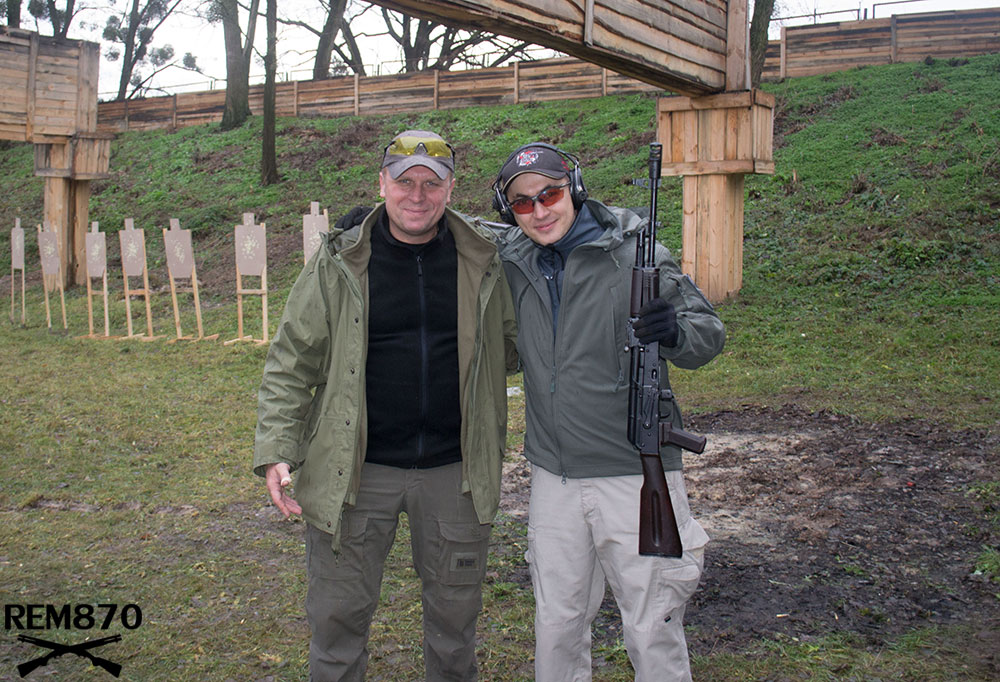
AK-47 Rifle
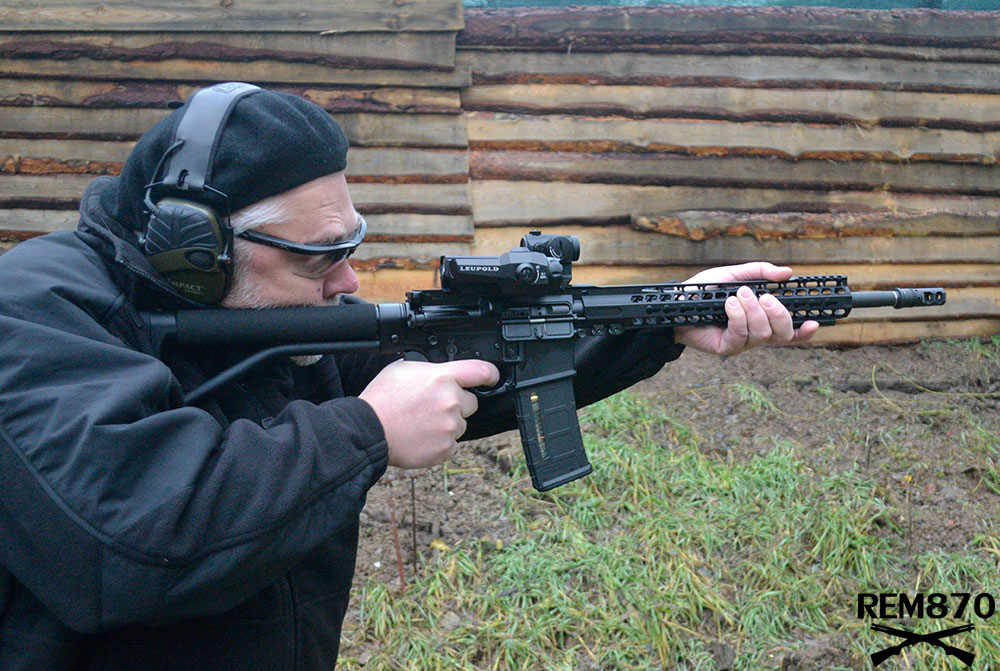
AR-15 Rifle with Leupold D-Evo Optics
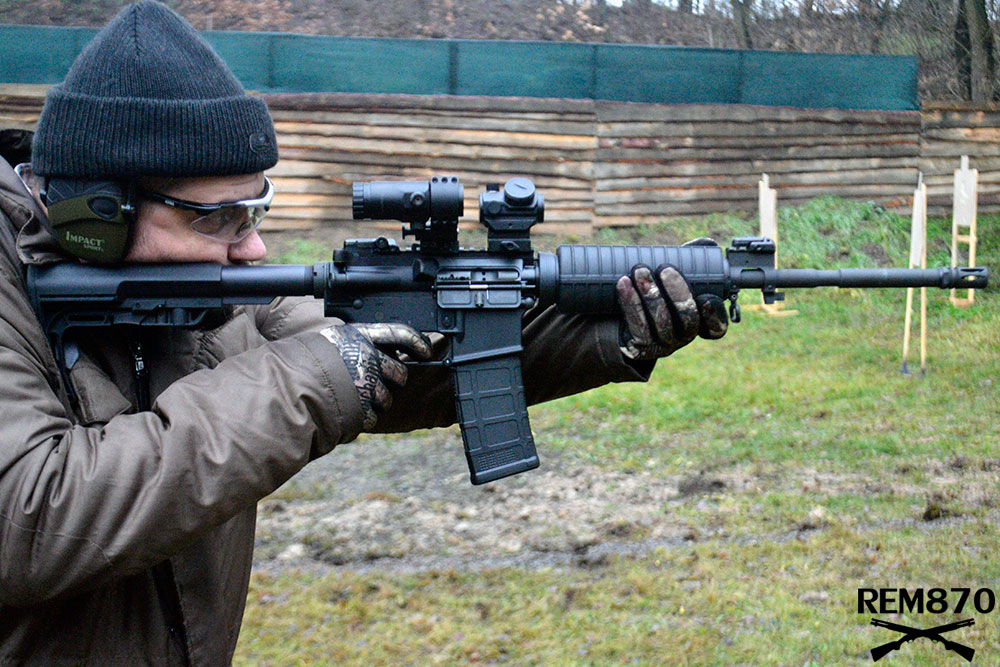
AR-15 Rifle with Magnifier and Holographic Sight
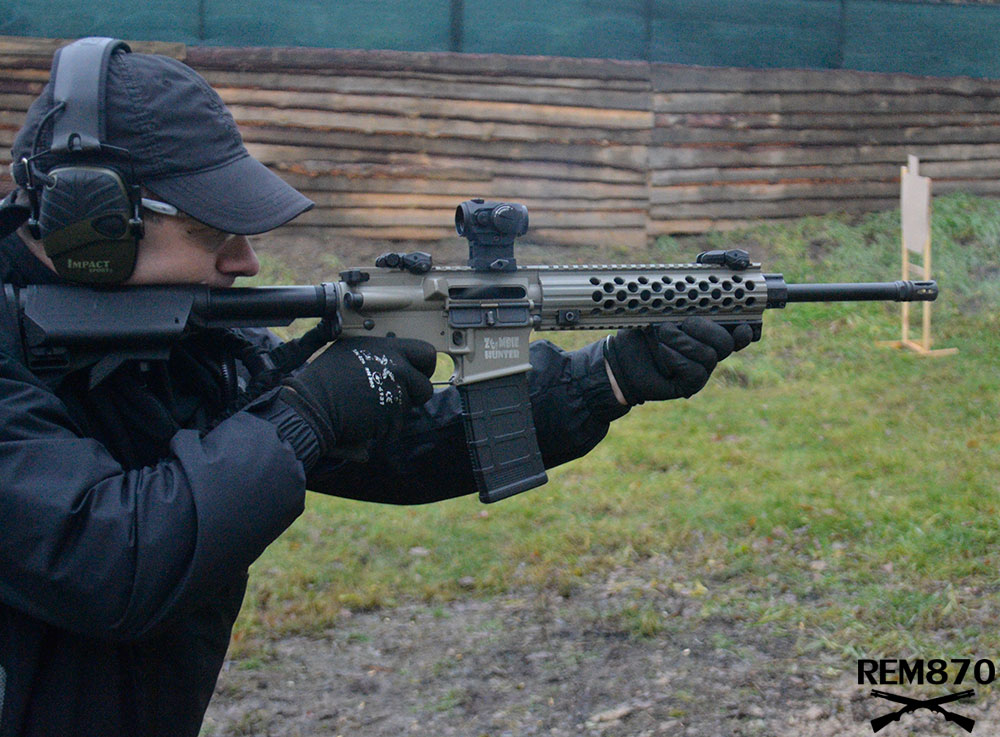
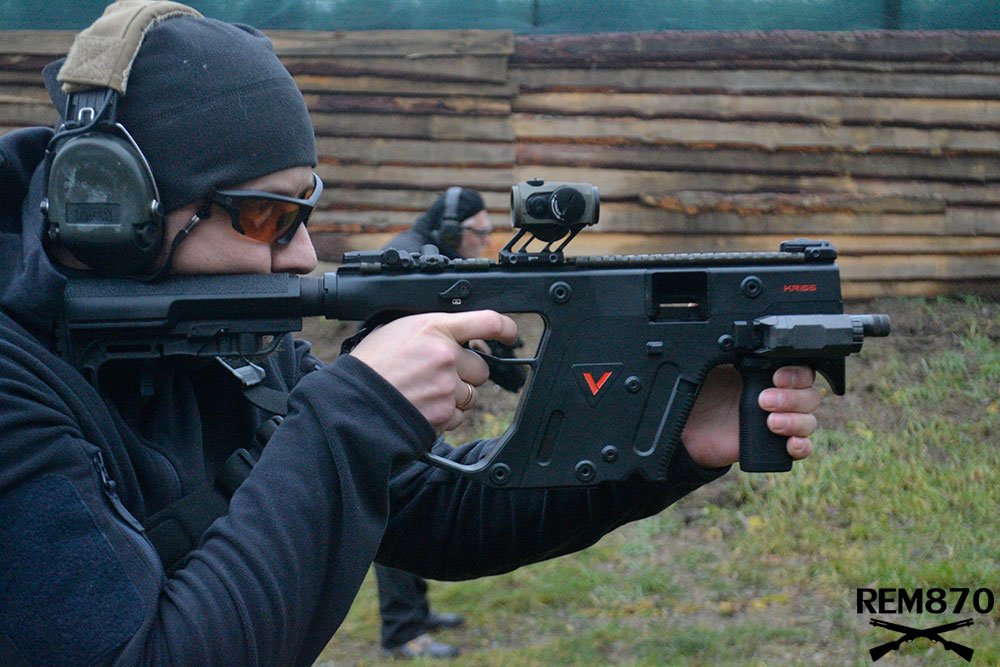
Kriss Vector Submachine Gun with Red Dot
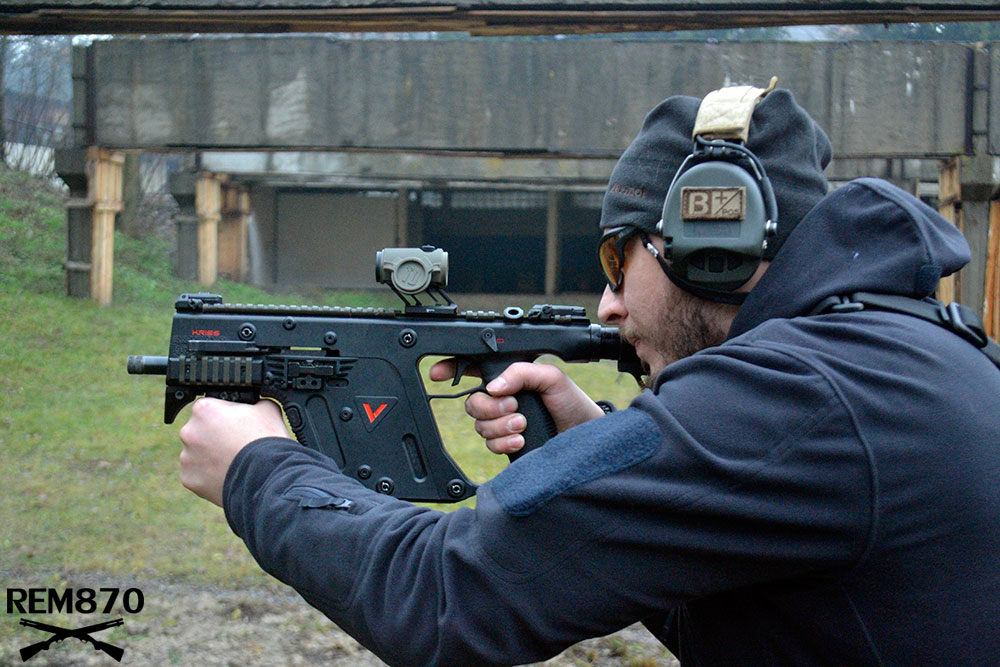
Kriss Vector Submachine Gun with Red Dot
Related post:
List of the Best AR-15 Upgrades
Determining Eye Dominance for Shooting
Seventy percent of men that are right handed are dominant in their right eye and the same applies to left-handed men. Thirty percent of men are what is called cross dominant, in other words they are right/left handed but are dominant in the opposite eye. Those that have a dominant eye that correspond with their handedness benefit from shooting with both eyes open. If you shoot right-handed but have a left, dominant eye you will have some trouble with accuracy and up until this point may not have realized why.
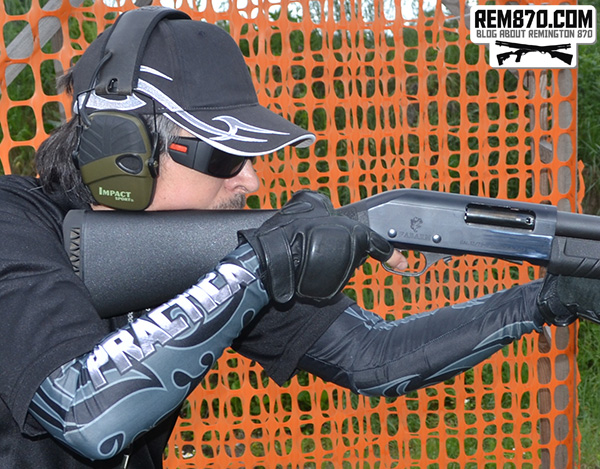
Shooter with Howard Leight Impact Sport Electronic Earmuff
Although rare, in men it may be that neither eye is the dominant one and this is called central vision. Women and young boys will usually not have one eye dominant over the other. This is why women find it more difficult to shoot with both eyes open and if right handed they can benefit from blocking the left eye and the reverse is true if they are left-handed.
If a shooter is not dominant in either eye, then changing from left to right shoulder will not correct the problem. However, you must first determine if this is the problem. Shoot from the left shoulder if left-handed and from the right if you are right-handed and try to block the opposite eye with modified shooting glasses.
Women and men can improve their shooting by blocking one eye if neither eye is the dominant one.
Humans have two eyes and the effect of having two eyes is called “binocular disparity”. One eye usually directs the pointing process, and the other eye (non-dominant) may see a blurred (double vision) image several inches off to the side. The mind typically blanks the so-called ghost image out.
Your dominant eye can change; it can be affected by stress, health problems or from simple eyestrain. Focusing on the front sight and the weapon’s muzzle instead of the target can also change your sight.
One of the simplest ways to determine eye dominance is to point at an object with both eyes open. Close one eye and if your finger is centered on the object then the open eye is dominant. Close the dominant eye and then your finger should appear off to the side. You can also make a circle with your thumb and forefinger and with both eyes open center the circle over a distance object. The eye that sees the image inside the circle when the other eye is closed is the dominant eye.
Dealing with Multiple Attackers
Shooting practice is needed and to become an advanced sharp shooter you will need hours of practice. However, much if not all of your practice is against single and stationary targets. The targets do not move, sneak up behind you or climb buildings to fire down upon you, in practice sessions anyways. Anyone that has confronted a shooter when there is no advanced warning or it was not a planned attack on your part has to wonder if the shooter is alone. Do you focus on the one you can see or should you look for others. What happens when there are multiple shooters/attackers?
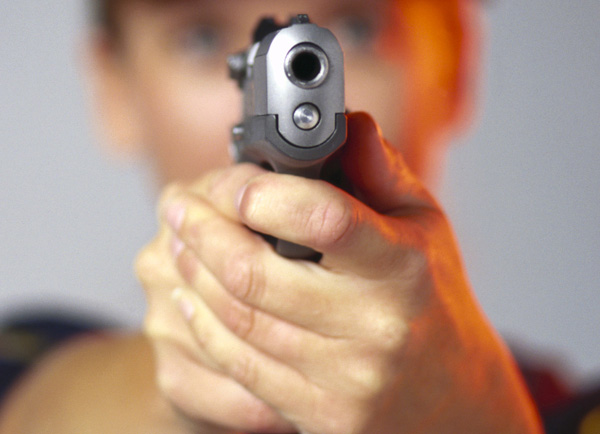
If you walk into a planned attack (ambush) the advantage goes to the attackers because if they are professionals they know where you will likely go for cover and/or concealment. They have set the stage and will not have left you with an escape route.
Unplanned firefights are hectic and either side can gain the advantage by thinking fast and moving even faster. Training is what saves lives during an attack; seeking cover immediately means you have denied the attackers that cover. Fast reloading is crucial and being able to fire on the move is as well.
When facing multiple attackers you cannot stay in one position because the attackers will flank you, shoot and then move and shoot on the move. If the attackers are advancing on you, the shooter in the center is likely the team leader. The center position allows them to see all team members and coordinate by hand movements. Team members must be able to see their team leader for instructions. Disable leader and others even if they are professionals will have a second of hesitation, which you must use to your advantage.
In years past gunfighters would face off to see who was the fastest draw. The shooters stood just a few yards apart and multiple shots were fired, and in some cases, neither shooter was hit. It was not always about who was the fastest but who was the most accurate.
You cannot fan your weapon and hope you hit someone. Regardless of the situation, you have to make your shots count. Pick out a target and hit it whether you are behind cover, on the move or sprawled on the ground. Do not take multiple shots at the same shooter, this allows the others to advance on you. Shoot and hit one and move to the next.
If for some reason, you have a scope remove it if possible. You will get tunnel vision if trying to track people through a scope. Open sight shooting or shooting over the sights allows you to track others while engaging one. Eyes move and then the body and weapon move with it and fire when your eyes make contact and if you have trained properly; your muzzle will be on target.
There are theories and plenty of advices from those that have never engaged even one shooter let alone multiple attackers. The reality is that firefights are chaotic, scary and over in seconds in most cases, unless both sides are “dug in” and both are looking for an advantage.
Standing your ground and facing your attackers will likely get you shot. You always want to be to one side or the other of any group that is a threat. Facing a group gives all of your attackers a clear shot. Move to the sides quickly to block fields of fire. Make the shooter move to get a shot and as they move to reengage, you shoot them first.
Unless you are in a military unit or with law enforcement, you will likely engage multiple attackers in your home, in a parking lot or possibly on a dark street. Your attackers while possibly experienced criminals will probably not have any tactical training will be under the influence of narcotics or alcohol and will depend on surprise and fear to gain the advantage.
Move quickly and fire at the one that has firearm. Once you see a weapon you cannot debate, you have to move. Disable that person with a shot and engage the next one. The one that you did not shoot will probably be rooted in place or will have fled because it takes years of experience to react lethally even for criminals. Most criminals have avoided being shot up to this point by being fast afoot.


